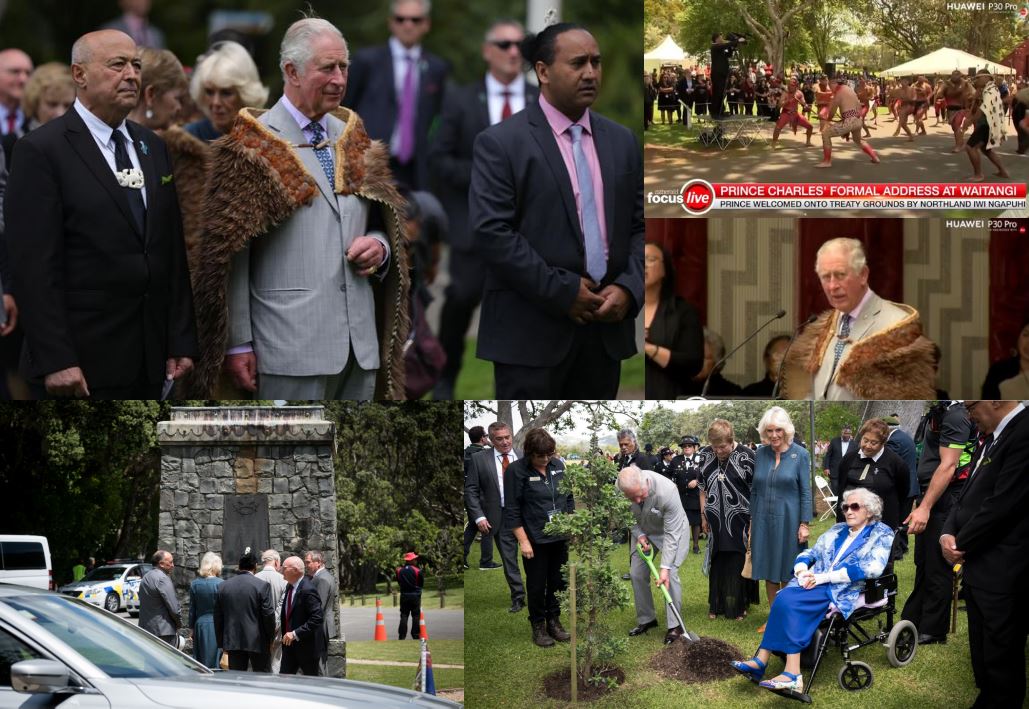
Signs the Royal Tour by the Duke and Duchess of Cornwall maintained British Monarchy’s Ancestral Claim to Realm of New Zealand
By The Snoopman
The Royal visit to New Zealand by the neo-feudal billionaire, The Prince of Wales, and The Duchess of Cornwall, is shown to be a charm offensive, crisis intervention, and legal exercise to maintain the hereditary rights of the British Monarchy over the Realm.
In Part I of this three-part investigation, The Snoopman shows the symbolic meanings embedded in the Prince’s ceremonial rituals were performed to reaffirm the sovereignty of Queen Elizabeth II. They also signalled the need to maintain the ‘Myth of Treaty Cession’ to avert a catastrophic collapse of the Fourth British Empire.
The Princes’ issuance of a new Queen’s Colour flag to the Royal New Zealand Air Force at Whenuapai and the loaning of a korowai to the Waitangi Museum were concrete symbols performed as rituals of sovereign conquest of a Realm gained by swindle, stealth and struggle. Just as brazenly, Prince Charles’s planting of a tree by the Waitangi Treaty House, and his ‘paying respects’ at the William Hobson Memorial, were concrete symbols performed as rituals of actual occupation and current possession.

These rituals were performed in accordance with a still-active piece of international law, known by its modern term — the Doctrine of Discovery — that emerged during the Crusades and was further developed from the 15th Century when the European Maritime Powers began making forays into the ‘New World’.

The Prince’s ‘Royal Charm Offensive’ rituals occurred at a time when the Treaty negotiations with Northland’s largest iwi, Ngāpuhi, is deadlocked – while the Crown avoids conceding that the tribe never ceded, or signed away, sovereignty in 1840.
It turns out, a parallel track was laid in 1839 and 1840 for the territorial acquisition and sovereignty takeover of New Zealand which occurred through legal instruments prior, during and after the hawking of the seven Treaty parchments to Māori chiefs. These moves, which were started and completed by the inky, feathery quill of Prince Charles’s great, great, great grandmother, Queen Victoria, perfected the incomplete title stealthily gained by Captain James Cook.

Northland’s largest iwi, Ngāpuhi has – in effect – endorsed a Waitangi Disney Treatyland mythology through their failure to present The Prince of Wales with a copy of the Waitangi Tribunal’s 600-page October 2014 report, which found that the Ngāpuhi Treaty Chiefs believed they were conferring Queen Victoria the right to appoint a governor to rule over Pākekā, and did not wittingly sign away their sovereignty.
Rituals of Occupation, Possession & Preemption/European Title
The November 17-23 2019 tour to the Realm of New Zealand by heir apparent to the British Throne, Prince Charles and his wife, Camilla Parker Bowles, is rife with royal rituals of occupation, possession and sovereignty.
The Princes’ issuance of new Queen’s Colours to the Royal New Zealand Air Force at Whenuapai and the loaning of a korowai to the Waitangi Museum were ‘concrete symbols’ performed as rituals of sovereign conquest gained by swindle, stealth and struggle. While, Prince Charles’s planting of a tree by the Waitangi Treaty House, and his ‘paying respects’ at the William Hobson Memorial, were concrete symbols performed as rituals of actual occupation and current possession.i
These rituals were performed in accordance with a piece of international law dating back to the Crusades and furthered developed between the European Maritime Powers from the 15th century as they forged colonial empires in the ‘New World.’
Moreover, the neo-feudal Prince — whose private estate the Duchy of Cornwall was founded in 1337 by Edward III, and is approximately 53,300 hectares, or 131,707 acres, spread across 23 counties of England and Wales and includes over 600 residential lettings and more than 700 agricultural tenanciesii — performed what The Snoopman calls a Royal Charm Offensive Spell at Waitangi. This spell, which can be categorized as concrete vocal symbol since the propagandist words were designed to lower expectations, construct acceptance to complete the treaty settlements and win loyalty to Royalty – as British subjects – through emotional hijacking.iii
Crucially, the billionaire heir to the British Throne manipulated his audience at Waitangi, new audiences and even the historical record when he incorrectly claimed New Zealanders had “faced up to the most painful periods of Her past in a way that offers an example to the world”. When, in fact, the deep history of Waitangi, the British Masonic Northern War of 1845-46 and the New Zealand Masonic Revolutionary War of 1860-72 contain hidden layers that are barely known to historians, let alone taught.
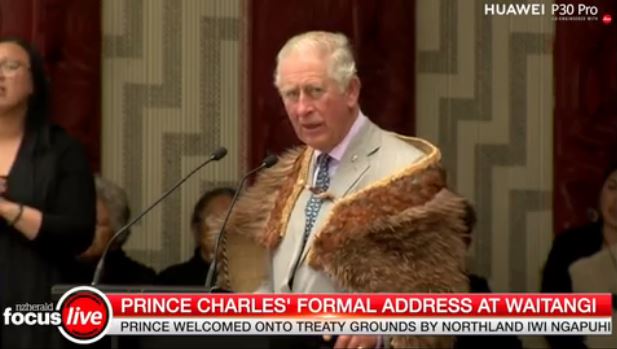
Furthermore, Prince Charles incorrectly remarked that “[t]wo peoples – tangata whenua and tauiwi – agreed to come together under the treaty and to work in partnership”. When, in fact, His Royal Highness’s great, great, great grandmother, set in motion the stealthy British takeover of New Zealand with her Royal Seal on the Letters Patent of Boundary Extension, dated June 15th 1839 – as The Snoopman outlines below and in “Part II: Treat or Tricks — The Enduring Waitangi Cession Myth”.
Conspicuously, the neo-feudal Royal billionaire claimed to “emphasize the strength of the commitment of successive sovereigns to the defining promise of this convenant” and with a brazen feigning of humility, he claimed to “reaffirm my commitment and that of my children and grandchildren to this bond between us and to ensuring that it endures for future generations.” Conspicuous – because the neo-feudal Prince did not actually specify what exactly was “the defining promise of this convenant.” Crucially, the Heir to the British Throne mentioned himself and his heirs when he went to say he, “reaffirm[ed] [his] commitment and that of his children and his grandchildren to this bond between us”. It would appear then, the defining promise of this convenant that Prince Charles was referring to is the Royal protection and security of the just Rights, Property, Peace and Good Order of the Native Chiefs and Tribes of New Zealand.
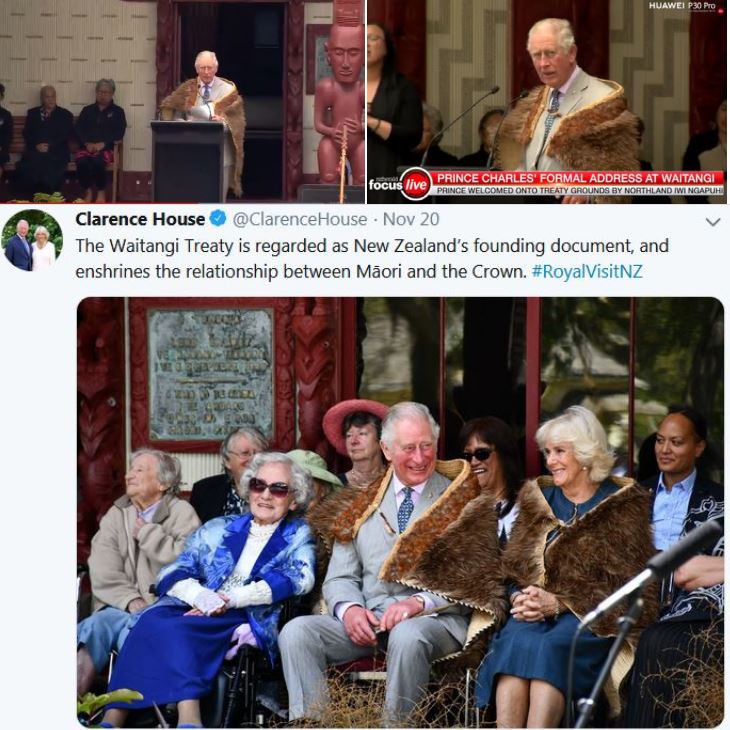
However, the bond of this ‘covenant’ was, in fact, an uneven exchange that could not be fairly described as an partnership, but rather as a paper roadmap to de-tribalized, landless and tax-enslaved serfs. Because – Māori were unwittingly lured into agreeing to be cast as ‘British Subjects’, and the signing Treaty Chiefs were tricked into giving up all their rights and powers of Sovereignty absolutely and without reservation to Her majesty the Queen of England – His Royal Highness at Waitangi nearly 180 years later was, essentially, peddling the English language version of the 1840 Waitangi Treaty. Therefore, when Prince Charles claimed a reaffirmation of his humble commitment to the bond between the Royal Family, Ngāpuhi and other Māori that the convenant endures, the Heir Apparent was communicating in a codified manner that the British Monarchy’s claim to the Realm of New Zealand as a Royal possession would collapse if the myth of cession by treaty was widely exposed as such.
Rituals of Sovereign Conquest — Whenuapai & Waitangi
The Prince of Wales, whose whirlwind tour ended on Saturday 23 November 2019, touched down at around 1:30PM at Whenuapai Airbase on Sunday 17 November 2019. The next day Prince Charles presented a new Queen’s Colours flag to the Royal New Zealand Air Force – he was performing rituals of Sovereign Conquest. The news media reported the new Queen’s Colours flag was presented to replace the worn one presented during Her Majesty’s 1953-54 Coronation Tour. The Royal Air Force and the Royal Navy possess Queen’s Colours flags for ceremonial use when the Monarch, or a Royal Family member, is travelling in an official capacity in the Realm of New Zealand.iv Such flags are a symbol of sovereignty and communicate the armed forces are ‘Her’ armed forces. The Queen’s Colours were reported to be “given as recognition of the RNZAF’s achievements and is the highest honour the monarch can present.” But what were these achievements?
In 1970, when the new Queen’s Colours were presented by Queen Elizabeth to the Royal Navy, the Monarch stated,

“Time moves on and conditions change. The new Colour bears the stars of the Southern Cross and this represents the absolute responsibility of the people of New Zealand for its own security and defence. This does not mean that New Zealand stands alone. The friendship of allies and associates will remain a strong as ever …”v

The new Queen’s Colours were presented by Prince Charles, whom wore his Royal Air Force attire. The intention of this performance was to activate a concrete symbol, since such rituals are performed in places of significance, as the late-executive director of the Flag Research Center in Winchester, Massachusetts, Whitney Smith (1940-2016), could have commentated if he were immortal. Because this ritual was performed in a gymnasium instead of outside on the Whenuapai Airbase due to Tāwhirimātea – the Māori atua of weather, including thunder and lightning, wind, clouds and storms and long sunny summer days – doing his best to forebodingly signal that Prince Charming was in fact a Dark Horse. Thus, the badly behaved weather perfectly ruined the scene’s optical link to the Prince’s mum’s performance of the same ritual more than half a century ago, and therefore, Tāwhirimātea successfully sabotaged the visual link to the airfield’s use during World War II.

However, according to kōrero eavesdropped in the crowded Kumeu Curry Leaf restaurant on Saturday night, it would appear there was either no time to summon Rūamoko, the Māori god of earthquakes and volcanoes – or it was considered a bit extreme to inflict a general disaster when heavy rain on a Prince’s parade should have been a clear enough signal that dark forces had gathered in the Gotham of the South Pacific, Auckland City, which is built on a vast volcanic field between two harbours and flanked by once magnificent forests and called Tāmaki Makaurau.
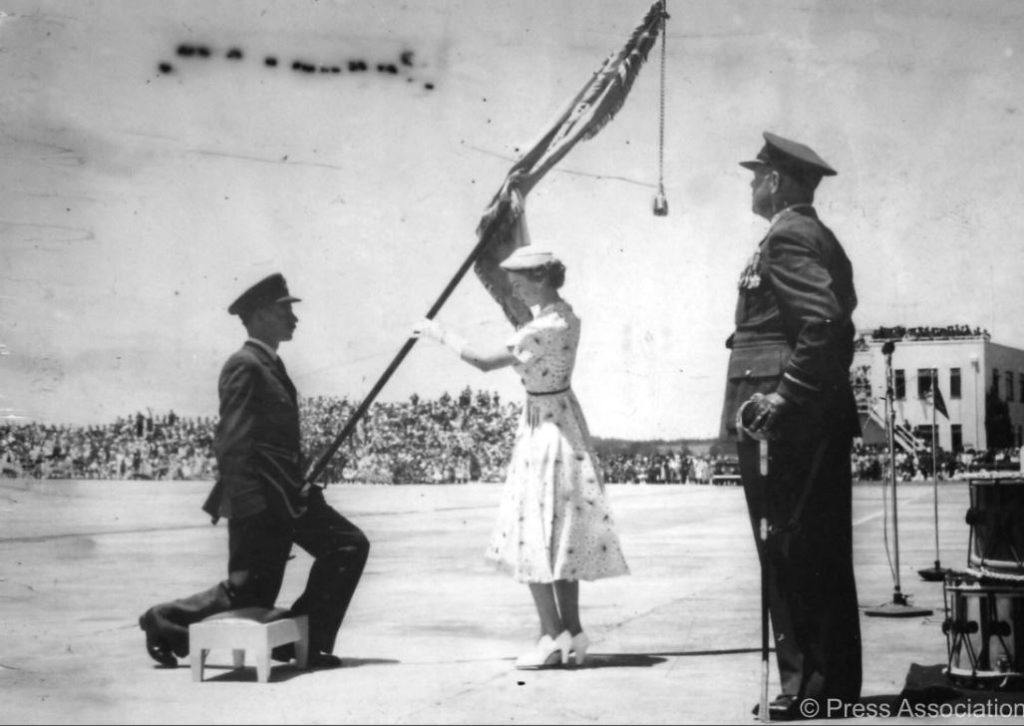
Instead, the Queen’s Colours ritual performed in the gymnasium visually referred more to British Élite’s exploitation of sport as a form soft power and in particular the spread of rugby and cricket throughout the British Empire, to distract, divide and defeat. The Queen Colours flag was laid over ceremonial drums bearing the coat of arms of the Realm of New Zealand, which is the world’s sixth largest oceanic territory – and is regarded as a hereditary possession of Her Majesty, and Her Heirs forever – evidently by virtue of the fraudulent treaty of cession allegedly made consciously and freely between Treaty Chiefs and the British Crown in 1840. The Realm of New Zealand has been the official title for the islands of New Zealand since 1956, and since the passage of the Royal Titles Act 1974, the monarch’s title in New Zealand has been the convoluted mouth-full, Elizabeth the Second, by the Grace of God Queen of New Zealand and Her Other Realms and Territories, Head of the Commonwealth, Defender of the Faith.
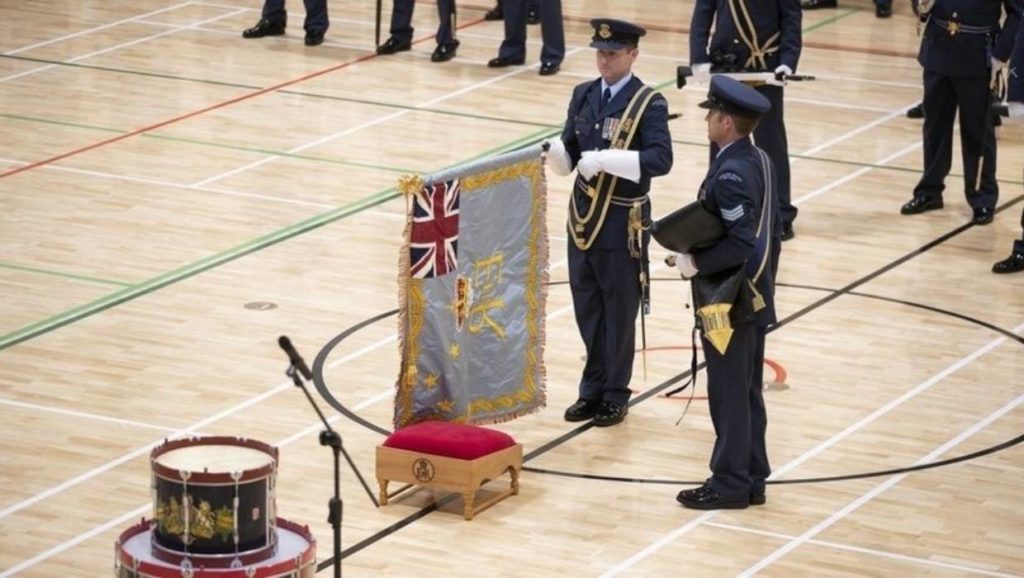
The timing of the royal visit – which was managed by the Department of Internal Affairs – is fascinating given that the arrival of The Duke of Cornwall with his wife, The Duchess of Cornwall, Camilla Parker Bowles, occurs one month before the Closing Ceremony at Te Māhia on December 15th of the ‘Tuia Enounters 250’ commemorations that marked the 250th Anniversary of the Endeavour Voyage that circumnavigated New Zealand in 1769-70. Fascinating – because Captain James Cook asserted he claimed possession of New Zealand at two places by showing the “English Colours”.
Such discovery rituals performed by Captain Cook included: hoisting flags, cutting the ship’s name and date into trees, making loose stone-mounded pyramids filled with musket balls, small shot, beads, silver coins, old pendants and other objects that could “stand the test of Time”, as well as assigning locations with English place names, claiming possession of lands in the name of King George III, recording encounters with ‘the Natives’ in journals, and drawing charts and maps that were published in Europe to lay England’s territorial claim as a Maritime Power over the islands of New Zealand.
Prince Charles – who was made Admiral of the fleet of the Royal New Zealand Navy, a Field Marshal for the army and Marshal of the Royal New Zealand Air Force, with the Queen’s approval ahead of his 2015 Royal Visit – planted a pohutukawa tree on the Waitangi Grounds on Wednesday 20 November 2019.
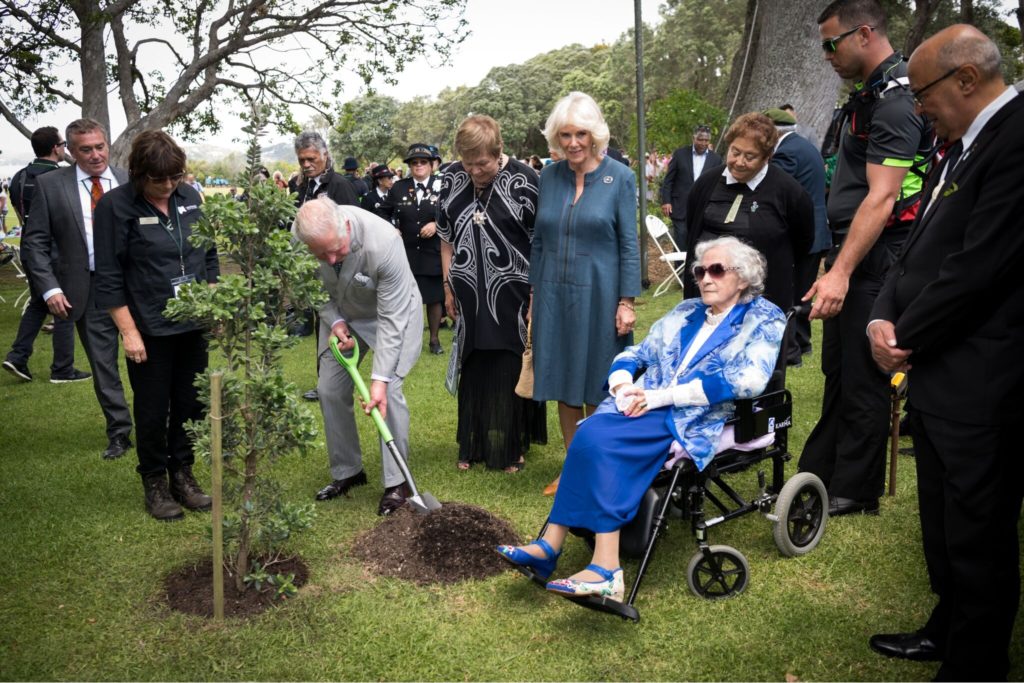
It would appear that this tree planting ritual – which took place near the ceremonial whare of a tree planted by Queen Elizabeth II during her 1953-54 Coronation Tour – was, in effect, a ritual of occupation and current possession performed in accordance with the Doctrine of Discovery set in motion by Captain Cook. Terribly, Freemason Captain Bro. James Cook was instructed to gain “the free and conscious consent” of inhabitants if he found lands inhabited that had not been previously discovered by any other European, without being told exactly how he might achieve that consent without his head becoming skewered on a stick. With this conjured juicy image, we think the reader will appreciate the last and juiciest paragraph of Captain Abel Janszoon Tasman’s instructions, which were more explicit – and, therefore, more enlightening, because this last paragraph goes a long way to explaining why most historians neglect to print this bit. Where the Dutch were openly callous, the British realized the trickery had longer-lasting chew when it came packaged with a cultivated politics of patience, politeness and professionalism, piety and playful pomp.
The Dutch United East India Company’s instructed Captain Tasman to plant symbols of “actual occupation” which were either a memorial stone or the Netherland’s prince flag, and were meant to be erected or hoisted as possession rituals to lay claim to any lands that the Dutch explorer discovered, touched and set foot on. Crucially, to fulfil the taking of possession of ‘discovered’ lands, Tasman was also supposed to gain the voluntary assent or submission of the people of any inhabited lands through “friendly persuasion”, or “planting a small tree in a little earth”, or “by erecting some stone with the people”, or by way of hoisting “the prince flag to commemorate their consent”.vi Since this tree planting ritual was performed in the company of Titewhai Harawira, it would appear that the Prince, in effect, gained the voluntary assent or submission of the inhabitants through friendly persuasion, as he planted a small tree in a little earth.
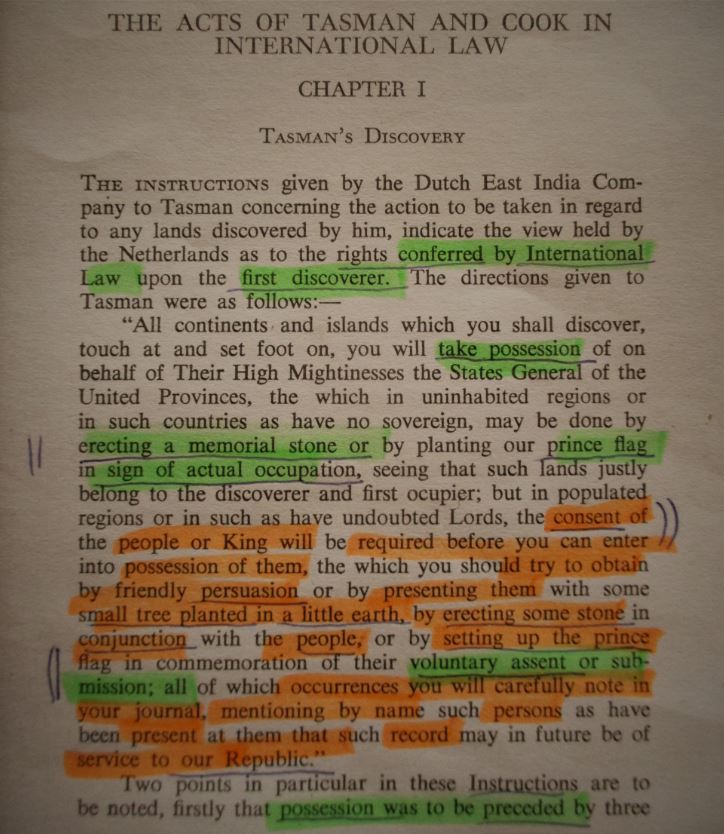
It is, therefore, crucial to recall that Titewhai Harawira was a member of the 1970s Māori land rights and sovereignty group, Ngā Tamatoa, along with her son, Hone Harawira. In 2000, Titewhai Harawira challenged the protocol of female speaking rights at Te Tii Marae, Waitangi, conferred to then-Prime Minister Helen Clark ahead her own as tangata whenua.vii Titewhai Harawira – whose ancestral ties are to Ngāti Hau and Ngāti Hine hapū of Ngāpuhi and Ngāti Wai tribes – was drawn close to the Prime Minister John Key at Waitangi in 2015, only to be cold-shouldered by this Rich-Lister neo-feudal oligarch, along with the rest of the Waitangi host community, in 2016. Key deceptively claimed he was denied any speaking rights at Te Tii Marae, which is Ngāti kawa and Ngāti rahiri. This controversy occurred amid the Key Ministry’s decision to host the signing of the 11-country super-economic bloc Trans-Pacific Partnership Treaty two provocative days before the Waitangi Day Anniversary.
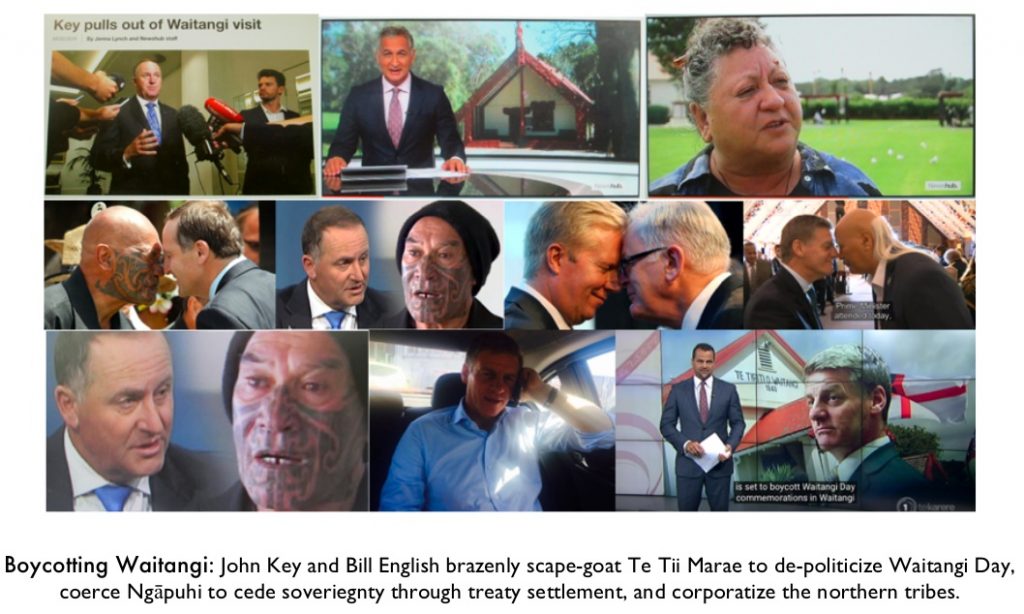
Key and Associates deployed this wedge tactic to exploit a hot spot to arouse intolerance in the watching news audience along a cultural divide of race. With this malicious move, the Key Government seized control of the one physical dimension at Waitangi open to Team Key to warp – Time. The other three dimensions – Space – were under Te Tii Marae, Te Whare Rūnanga and Ngāpuhi iwi jurisdiction. This exclusionary blackballing move was designed to divide the Waitangi host communities of Te Tii Marae and the Waitangi Treaty Grounds, coerce Ngāpuhi to settle with the Crown and avoid admitting that Ngāpuhi never ceded sovereignty in 1840 – as The Snoopman showed in his Waitangi 2018 report, Harnessing the Herd to Hide a Historical Heist.viii
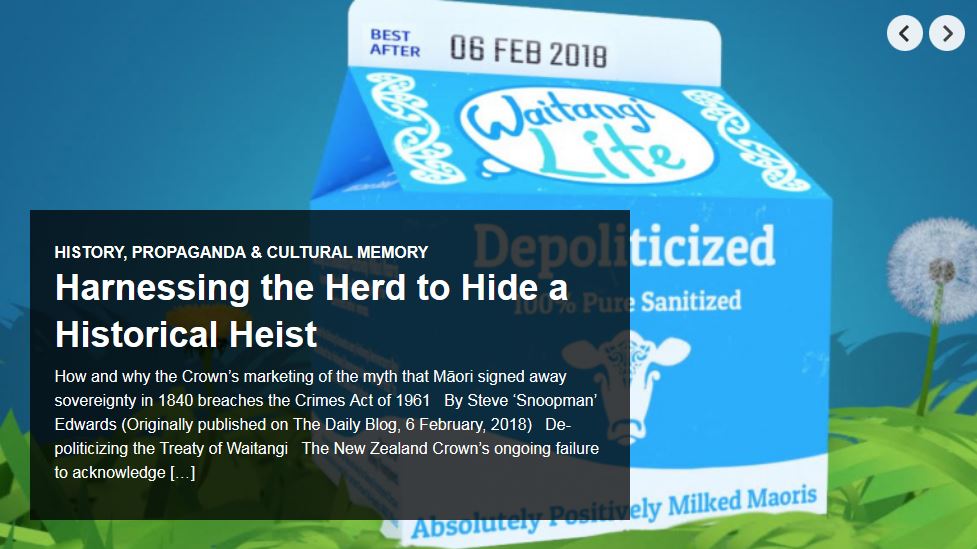
Not only has the New Zealand Crown continued to avoid fully disclosing to this crisis-ridden neo-feudal realm the how exactly, the who exactly, and the why exactly of the machinations to gain paper sovereignty and substantial sovereignty over New Zealand. During the Ardern Coalition Government’s tenure, the Crown has also avoided fessing-up that neither Ngāpuhi or any other iwi or hapū signed away their sovereignty in 1840. Instead, the Government, through its Department of Internal Affairs, hosted the Royal Prince Charming Tour 2019 to cement the myth of cession some 250 years after Captain Cook claimed he performed possession rituals at one of two places on his Endeavour Voyage – on, or around, November 15th 1769 at Mercury Bay/Te Whanganui-a-Hei on the Coromandel Peninsula.
To this emotionally manipulative end, the British Royal Family has loaned an heirloom to the Waitangi Museum. The 2.6m-long korowai, or a feathered cloak woven with flax, had been gifted to Queen Victoria by Ngāpuhi chief Reihana Te Takauwau on a visit to England in 1863. Chief Te Takauwau met with the Patronness of English Freemasonry Queen Victoria in July 1863. He was travelling as a part of a theatre company set up by Wesleyan lay preacher, William Jenkins, whose business venture was to demonstrate to Māori the power and resources of Britain − and evidently its class system since the Wesleyan travelled first class on the Ida Ziegler, while his guests were given worm-infested biscuits which they rightly threw overboard and were instead fed by British soldiers.
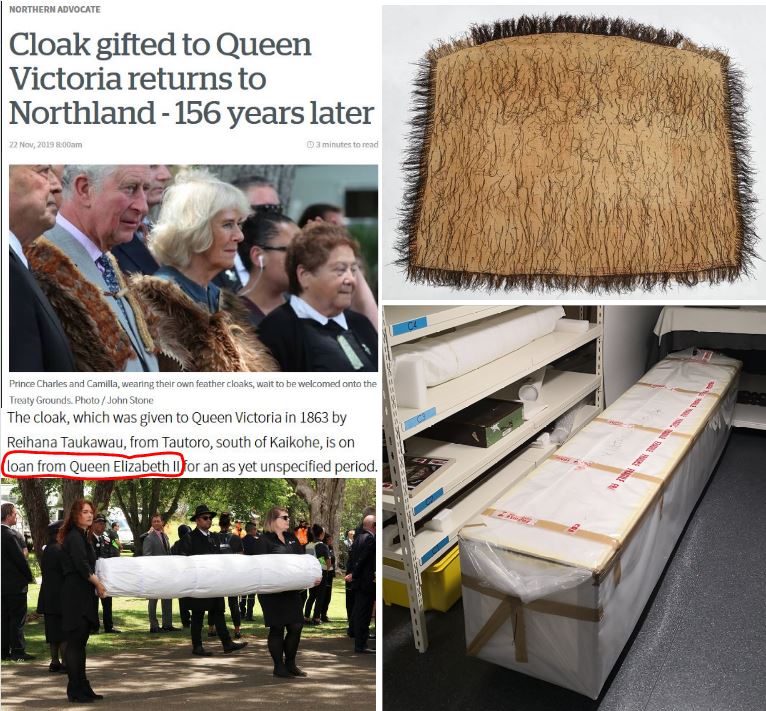
Ironically, before this theatre company had reached England, Queen Victoria’s son, HRH Prince George William Frederick Charles, who was the Commander-in-Chief of British Armed Forces, signed orders on April 13th 1863 for the 43rd, the 50th and 68th Regiments to travel to New Zealand in accordance with the war plans of Governor George Grey. Also ironically, another Wesleyan lay-preacher, Thomas Russell, who as the primary founder of the Bank of New Zealand played a pivotal role in brokering a £3 million war loan for the Colonial Government, also facilitated a rolling overdraft to meet military expenses and distributed war resources as Minister of Colonial Defence. It would appear then, that the Prince of Wales’s charm offensive contained carefully codified communications designed primarily for an élite audience attuned to the language of metaphor, Discovery Doctrine rituals and crisis rituals to retake control of national narratives.
Because, at Waitangi, the Prince appeared to signpost the solution in the dispute at Ihumātao over land confiscated by the Crown in July 1863 with the symbolic loan of a korowai gifted to Queen Victoria by a Ngāpuhi chief in July 1863, to signal that a tax-herd funded buy-back via a Crown loan to Auckland Council might do the trick. Magically, a leak to Radio New Zealand during the Royal Tour week reported the idea of a Crown loan to buy-out Fletcher Building Limited’s stake in the land at Ihumātao – and this leak appeared to be a strategically-timed test the waters ritual.ix
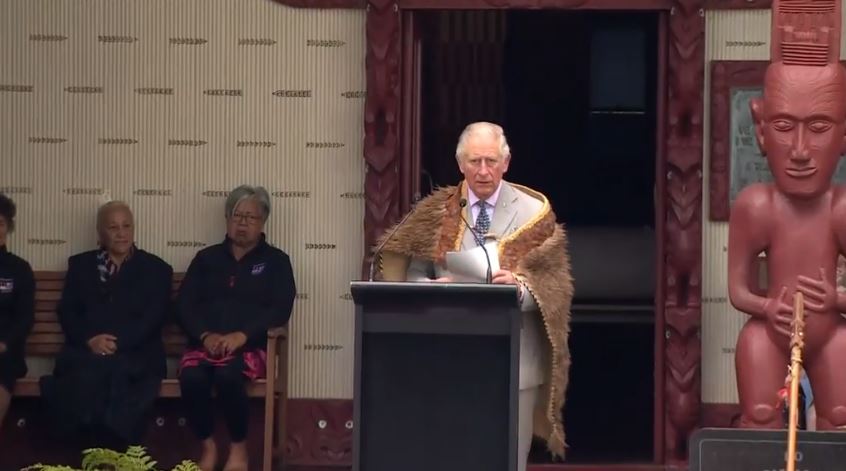
Meanwhile, the Crown is attempting to forge a settlement claim with the Far North’s largest tribe, Ngāpuhi. Brazenly, the Crown has ignored the critical and primary finding of the Waitangi Tribunal’s October 2014 report. The Waitangi Tribunal – which is a body of the Ministry of Justice – found that neither Ngāpuhi nor any other iwi or hapū signed away their sovereignty when the seven Treaty sheets that were hawked around New Zealand from early-to-mid 1840. Instead, the Waitangi Tribunal – which is a body of the Ministry of Justice – found that the Treaty Chiefs were thought they were conferring Queen Victoria the right to appoint a governor to rule over unruly Pākehā. Māori were fooled by the critical and deliberate language translation differences, the mission to persuade, and the speed of the signings – all of which had cumulative lasting effects.
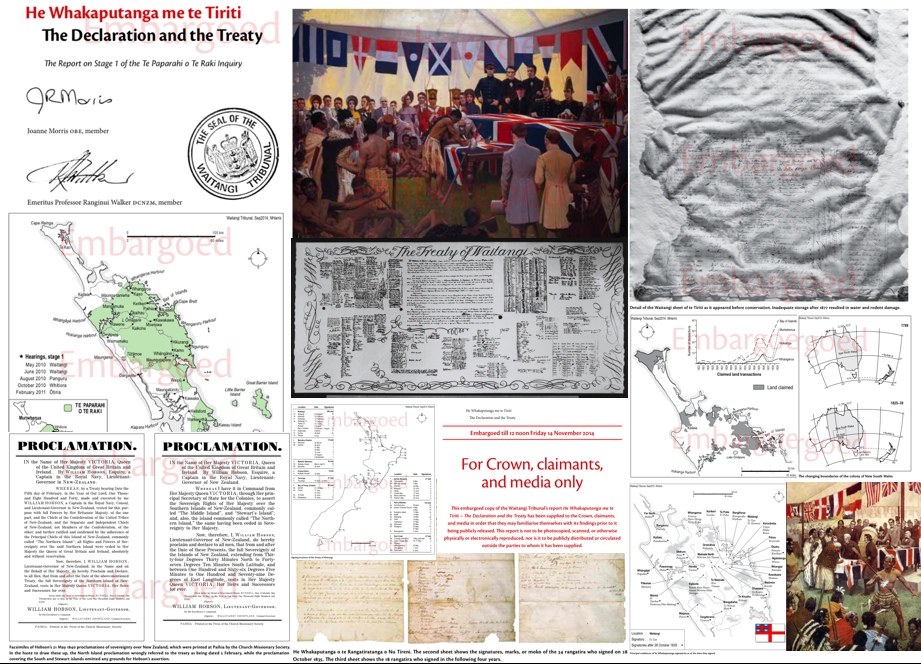
Frustratingly, the Ngāpuhi tribe’s male leadership at the upper marae on the Waitangi Treaty Grounds capitulated to Prince Charles’s charm offensive. To the exacerbation of many inside Ngāpuhi and external to the tribe whom know at least some of the truth about Crown’s ‘Treaty Myth of Cession’, this subset of Ngāpuhi’s male leadership displayed a remarkable lack of ballsiness, principled resolve and far-sighted vision – because by their submission to Royalty they have, in effect, endorsed the British-penned Treaty myth – which they know not be true.
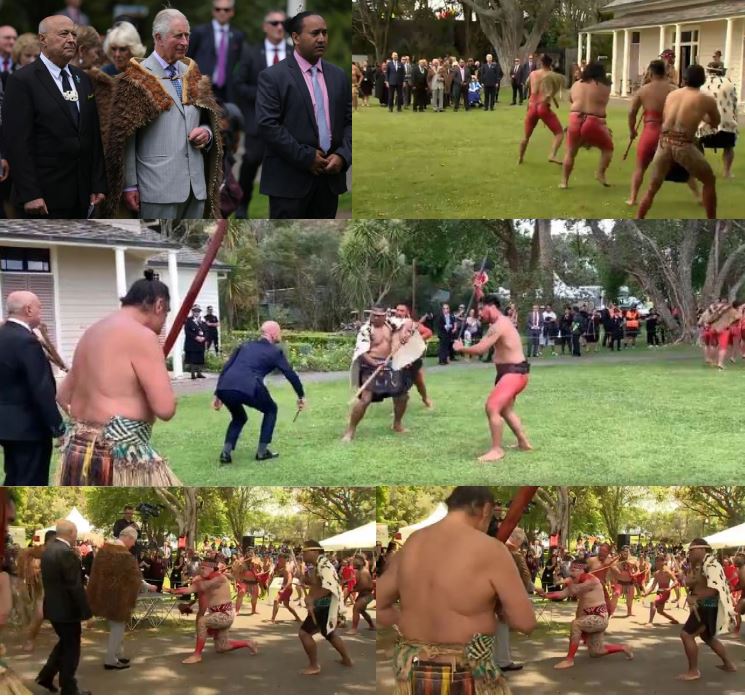
To New Zealand Ruling Class élites – whom are schooled in this epic, exquisitely evil trickery – and whom have an ear attuned to the codified communications, the encoded euphemistic language and the emotional hijacking of such charm offensives – the prince’s politely racist aristocratic white supremacist rhetoric was audible. For one thing, the Duke of Cornwall’s ancestral Duchy of Cornwall is 206 square miles, or 131, 707 acres. The Prince of Wales’s private estate is ancestral possession, which happens to be 10,293 acres less than the land that first British Resident and author of the English version of the Waitangi Treaty, James Busby, swindled and stole from Northland rangatira prior to the Treaty signing.
Given that the Waitangi Treaty Grounds is on land acquired by Freemason Charles Bathurst, 1st Viscount Bledisloe, when he was Governor of the Dominion before it became a Realm, and that the consolidation of the Colony occurred during the Governorship of Freemason Governor Bro. George Grey, who was Commander-in-Chief during the peak period of the New Zealand Masonic Revolutionary War of 1860-72 and at a time when Queen Victoria was Patronness of British Freemasonry – Prince Charles’s reaffirmation of his commitment to the ‘Treaty bond’ needs to be viewed as a brazen ratification of the historical, Royally Chartered swindle.
The Pākehā that dominate New Zealand’s Rich-Lister Oligarchy, Wellington’s Political Élite and the Ruling Class would have laughed their tits off the day after, on Thursday 21st November, when the Royal Visitors had no public engagements and therefore had time to monitor the political barometer.

Particularly, as the Prince of Wales paid homage, at a stone memorial erected to commemorate the ‘Waitangi Treaty Theatre Director’, Captain Hobson. Because – despite the excellent research of both Te Kawariki & Network Waitangi Whangarei and that of the Waitangi Tribunal in their reports on the 1835 Declaration of Independence and the 1840 Waitangi Treaty, these multi-year ground-breaking investigations missed that fact that the Treaty ruse not only spun on a fulcrum of translation differences.
The mission to persuade, or charm offensive, which occurred with unseemly haste, along with the cast and props including the treaty sheets, quills and ink, was New Zealand’s second theatre company – the first being Captain Cook’s voyages. As the stage director of what was really a ‘Waitangi Treaty Theatre Company’, Captain Hobson, leaned on the Protestant missionaries to help him persuade the rangatira that the benefits of a treaty with the British.
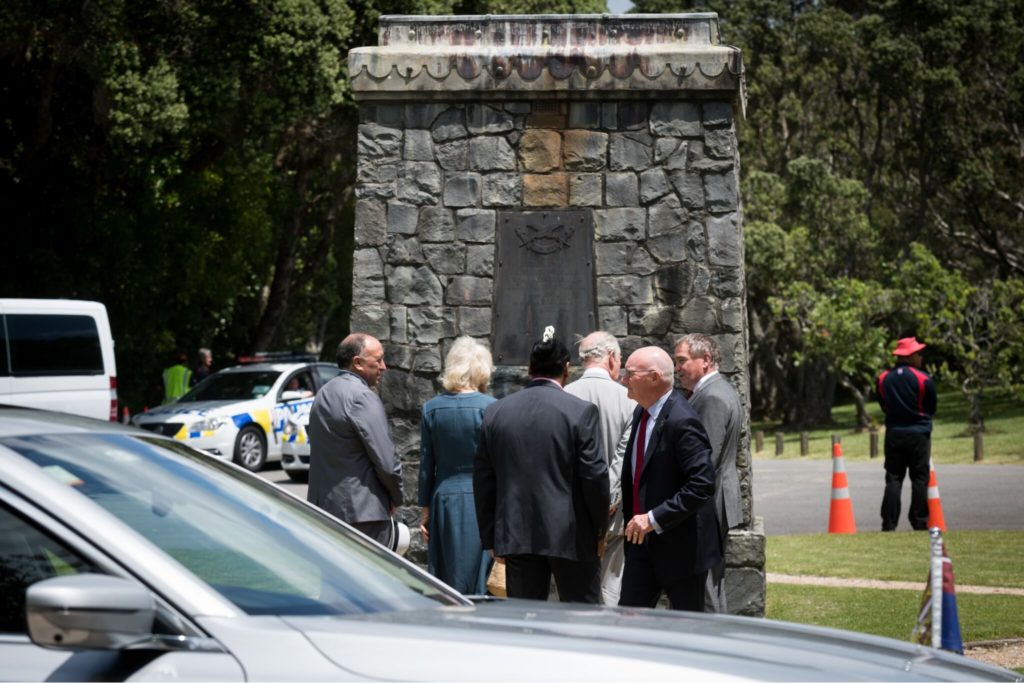
The activities of the ‘Treaty Cliqué’ can be viewed as screening actions, such as language mis-translations, to mask later so-called unwitting misdeeds, by drawing upon David Luban’s paper, “Contrived ignorance”, published in The Georgetown Law Journal in 1999. In presenting his “Structure of Contrived Ignorance” model, Luban viewed screening actions and so-called unwitting misdeeds as a unitary whole rather than separated by time-frames. Luban proposed viewing the version of the self that wittingly performed screening actions to preserve his own oblivion as the principle actor, while the agent is the later self at the time of the unwitting misdeed, who effectively ratifies the earlier self’s choice to compartmentalize or screen off potential knowledge of wrongdoing.
For example, Captain William Hobson’s claim that he had done his best to explain the full bearing of the Treaty to rangatira – in response to Protestant missionary printer William Colenso’s interjection as Chief Hone Heke got up to sign – can be seen as a screening action. Captain Hobson was masking his anticipated unwitting misdeeds to declare British sovereignty over all of New Zealand a few months later, knowing full well that he was, in effect, staging a piece of imperial theatre to mask a stealthy takeover.
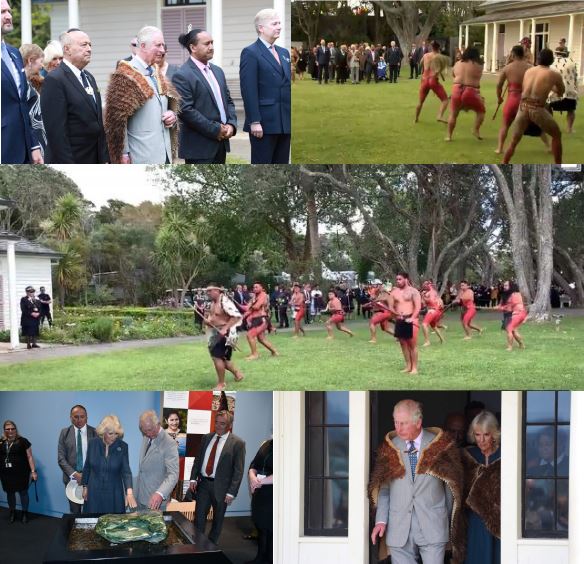
Furthermore, as The Snoopman outlines below – with deeds, texts and tactics, a parallel track taken in 1839 and 1840 by the British Crown to gain British Sovereignty was set in motion on 15 June 1839 with the Letters Patent of Boundary Extension that expanded the territory of New South Wales to include New Zealand. And following a series of legal moves taken prior to, during and following the ‘Waitangi Treaty Theatre Production’ – those moves culminated in Queen Victoria signing the Royal Charter for Severance (or Charter of 1840), on 16th November 1840 and thereby established New Zealand as separate colony from New South Wales.
Therefore, the 2012 report Ngāpuhi Speaks commissioned by Kuia and Kaumātua of Ngāpuhi, and the 2014 report produced the Ministry of Justices’s Waitangi Tribunal – both missed the real significance of the parallel legal moves that included proclamations, new commissions, swearing-in officials, letters patent, legislation, gazetted notices and a royal charter that ‘legalized’ the British Crown’s annexation of New Zealand as a colony of her Majesty’s Empire. Therefore, Prince Charles paid homage to Captain William Hobson at the stone memorial on the Waitangi Treaty Grounds, he was essentially paying respect to Captain Hobson for pulling on an epic swindle to gain a huge treasure the size of the Kingdom of Great Britain at so little cost, while the Prince was also acknowledging that New Zealand joined the Third British Empire (1815-1945) when his own great, great, great grandmother signed the Letters Patent of Boundary Extension that expanded the territory of New South Wales to include New Zealand on on 15 June 1839.
The hosting of official visitors, including the Royals, is problematic for Ngāpuhi, the hapū groups that comprise the iwi, as well as other hapū and iwi of Northland and the rest of New Zealand because it’s jurisdiction is unlike most others, since it is governed by the Waitangi National Trust Board which is controlled by its enabling Waitangi National Trust Board Act of 1932 and its associated Amendment Act of 2015.
The Board’s governing legislation stipulates the appointments of: a member of the family of Hone Heke, a family member of Maihi Kawiti, a family member of Tamati Waka Nene, and a family member of Pomare; a family member of the Henare clan, a family member of the late Archdeacon Henry Williams; representative of the family of the late Edward Gibbon Wakefield; a person who in the opinion of the Board is a person prominent in the life of the country as a statesman or historian; the Governor-General as an honorary patron of the trust; a Crown representatives group — the Prime Minister; and the Minister for Arts, Culture and Heritage; and the Minister for Māori Development; and a Nominated Members group comprising two people, with one member appointed by the Prime Minister to represent the Government and one member appointed by the Leader of the Opposition. Therefore, the Waitangi Treaty Grounds marae – which is located on land purchased by Lord Bro. Charles Baron Bledisloe of Lydney in the County of Gloucester in England and endowed to the Waitangi National Trust Board at a time when he was Governor of the Dominion and Grandmaster of New Zealand Freemasonry – has more in common with a theatre than an ancestral wharenui.

Therefore, Prince Charles’s tree planting ritual on the Waitangi Treaty Grounds, and gifting by a loan the korowai as a present for display at the Waitangi Museum, and his ‘paying respects’ at the stone memorial of the ‘Waitangi Treaty Theatre Company’ director, Captain Hobson – look like they were rituals of actual occupation and current possession. The Prince of Wales’s loaning of a new Queen’s Colours flag to the RNZAF at Whenuapai Airbase appears to have been a Sovereign Conquest ritual. These rituals were in keeping with the still active piece of international law dating back to 15th Century, known by its modern term, the Doctrine of Discovery.
378.1642-2020: Applied Discovery Doctrine in the Realm of New Zealand — A Course in the Waitangi Treaty Theatre Company’s Enduring Cession Myth
As indigenous law scholars Robert J. Miller and Jacinta Ruru stated in the West Virginia Law Review:
“When Europeans planted their flags and crosses in these ‘newly discovered’ lands they were not just thanking God for a safe voyage; they were instead undertaking the well-recognized procedures and rituals of Discovery designed to demonstrate their legal claim over the lands and peoples.”x
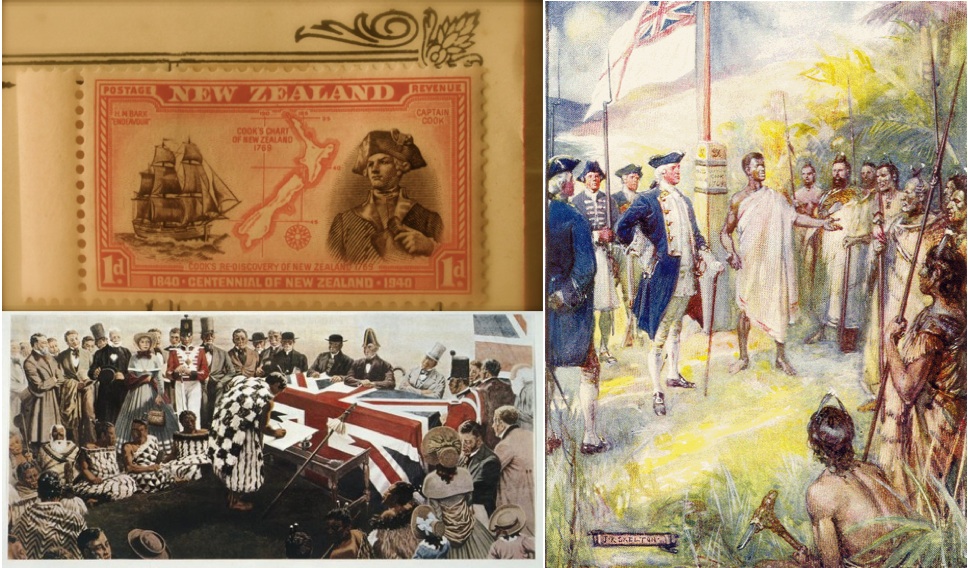
The Doctrine of Discovery was a secret piece of international law that emerged during the Crusades, which targetted the ‘Holy Lands’ between 1096 and 1271, when the Vatican Empire asserted a worldwide papal jurisdiction to justify Holy Wars fought by the Knights Hospitallers, the Knights Templars, and the Teutonic Knights.
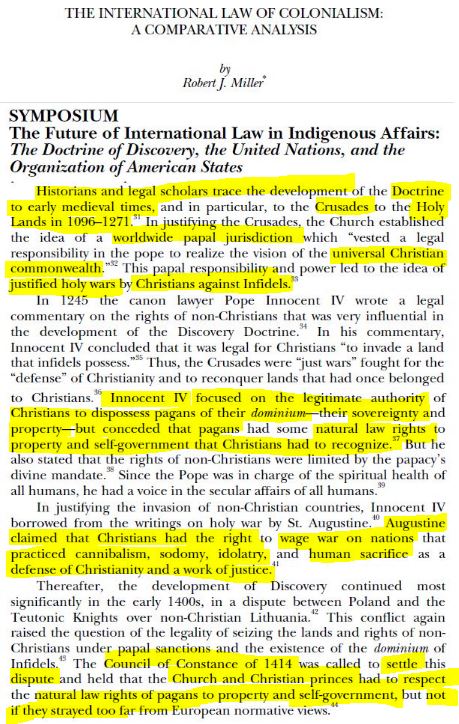
Muslim Saracens were cast as ‘Infidels’ and Christians could ‘legally’ reconquer their lands by divine mandate, which limited the property rights and self-government of non-Christian peoples, to serve the diabolical ambition to forge a universal Christian empire.xi
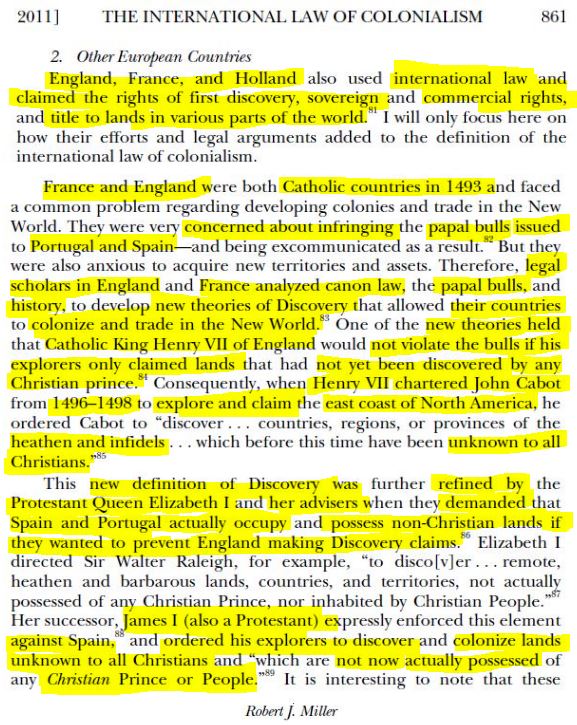
The Discovery Doctrine was further developed between European nations in the 15th Century, from whence they were forging maritime empires, and was designed to mitigate the chances of competing nations making expensive war with each other at the cost of much ‘blood and treasure’.
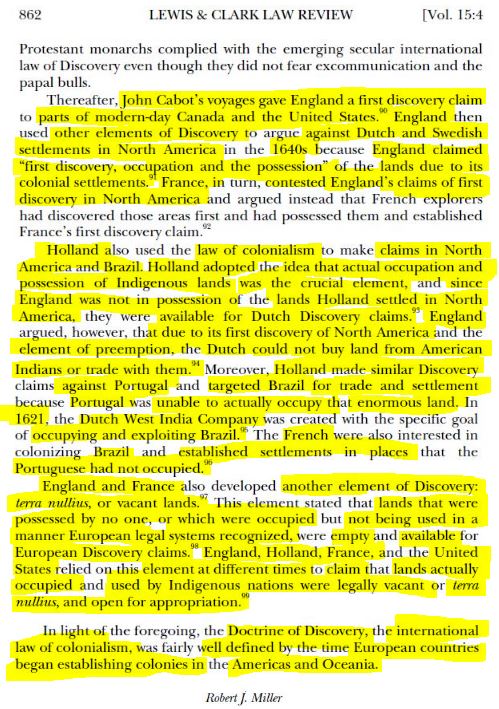
The European Maritime Powers thought it would be easier to gain territory off ‘New World’ indigenous peoples, whom were cast as ‘savages’, rather than from their more technologically-even European competitors.
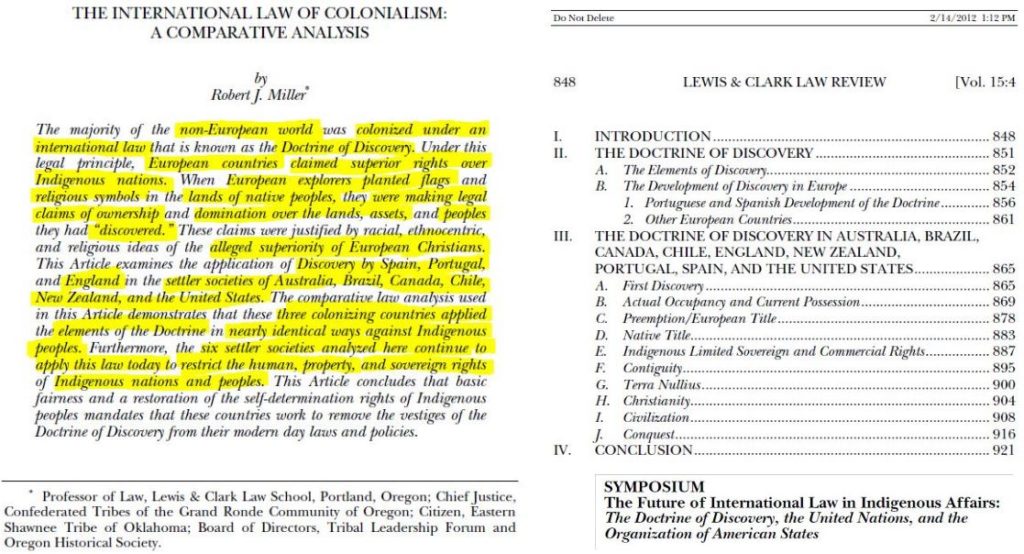
As Professor Miller has stated, a European Power gained property and sovereign rights over ‘undiscovered’ lands and indigenous peoples upon First Discovery, although the titles were considered incomplete even if the European nation took possession on paper, following the performance of discovery rituals such as raising flags and claiming the territory for a royal or papal monarch. However, a European Title could only be produced from First Discovery if the European country occupied and possessed their newly found lands within a reasonable period, to complete the annexed title. This often occurred by fort building and establishing settlements.
In New Zealand, the element of Actual Occupancy and Current Possession, or Settlement, was exercised by British settlers, including Protestant Missionaries whom swindled large tracts of land from Māori. Indeed, it was through this Settlement element that the whole New Zealand territory was acquired by the exercise of Royal Prerogative Powers, when no less a figure than Queen Victoria signed a decree known as the Letters Patent of Extension on June 15th 1839, to enlarge the boundary of New South Wales which had the effect of enveloping all of the islands of New Zealand within the jurisdiction overseen by Governor George Gipps.xii

It turns out that the British Crown gained paper sovereignty over New Zealand by laying a separate track to the Treaty-making rituals, and were consistent with English constitutional law. These legal moves included proclamations, new commissions, swearing-in officials, letters patent, legislation, gazetted notices and a royal charter that solidified the establishment of New Zealand as a colony of the British Empire by perfecting the incomplete title stealthily gained by Captain Cook. This parallel track was laid at the time when there were three classes of colonies designated according to their mode of origin: by settlement (or occupation), by conquest and by cession.xiii
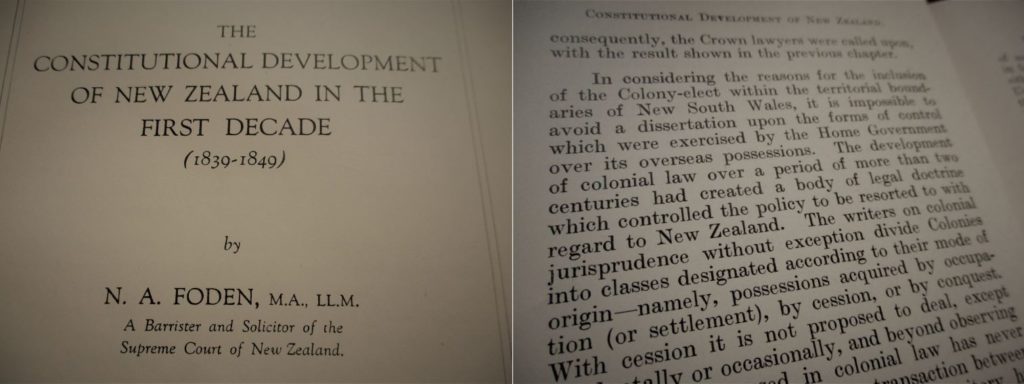
As such, the move to annex New Zealand was made on the basis of settlement, justified on grounds that 2000 Britons continuously occupied New Zealand, as government historian Richard Hill found while researching Policing the Colonial Frontier: The Theory and Practice of Coercive Social and Racial Control in New Zealand, 1767-1867 – which was published in 1986 for the Department of Internal Affairs.
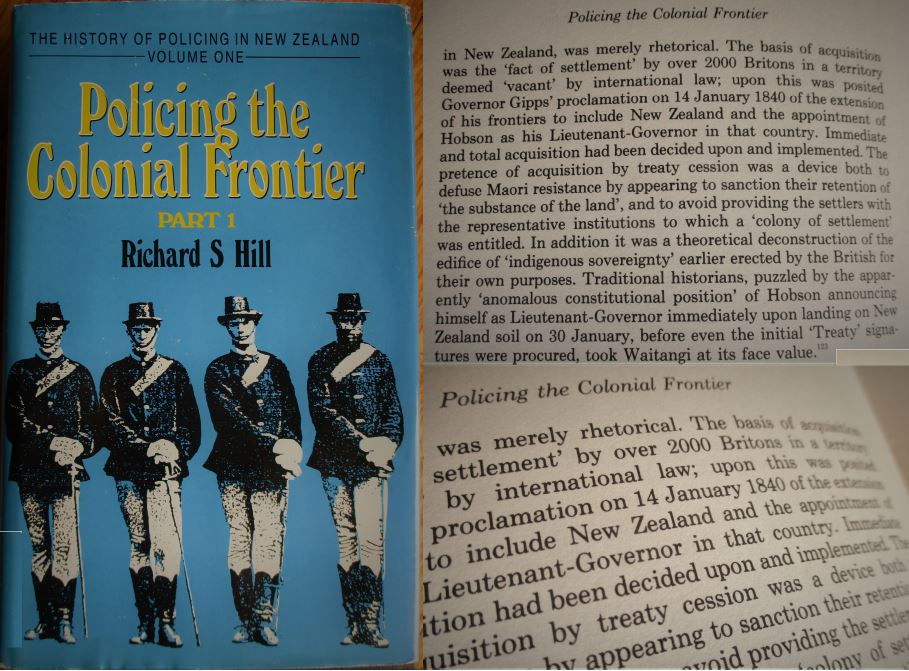
In his 1965 book, New Zealand Legal History (1642-1842), Norman Arthur Foden (1894-1978) pointed out that the proclamations and legislation were “pushed forward” in parallel to Captain William Hobson’s activities, and were not merely legal actions taken should Captain Hobson have failed to gain cession.xiv
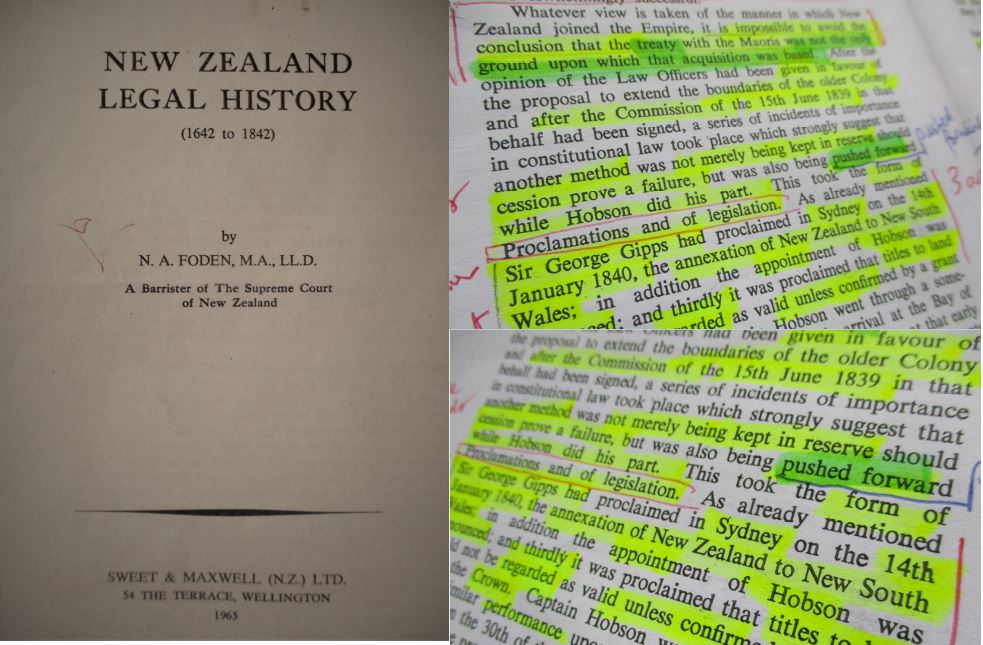
The role of the Treaty-making rituals as theatre becomes clear when it is learned that cession of territory by indigenous peoples to a European power was considered invalid in colonial and international law because such ‘natives’ could not possibly be expected to fully comprehend the implications of signing away sovereignty in a treaty, since the power imbalances would be exponential, as Norman Arthur Foden (1894-1978), found while researching his 1938 book, Constitutional Development of New Zealand in the First Decade (1839-1849).xv
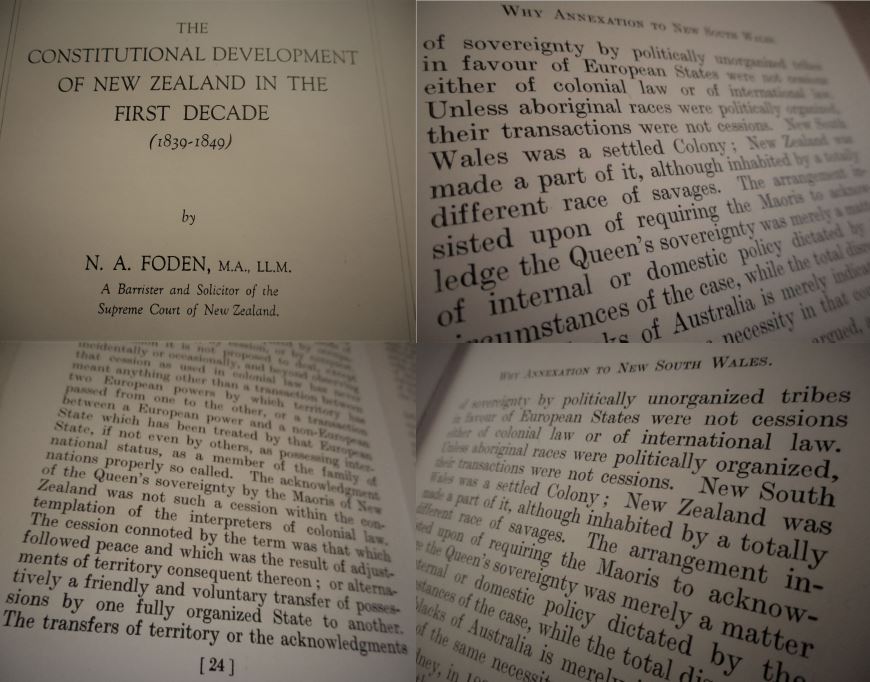
While working as a historian in the Historical Branch of the Department of Internal Affairs, Hill found that the cession of sovereignty by treaty was a myth.
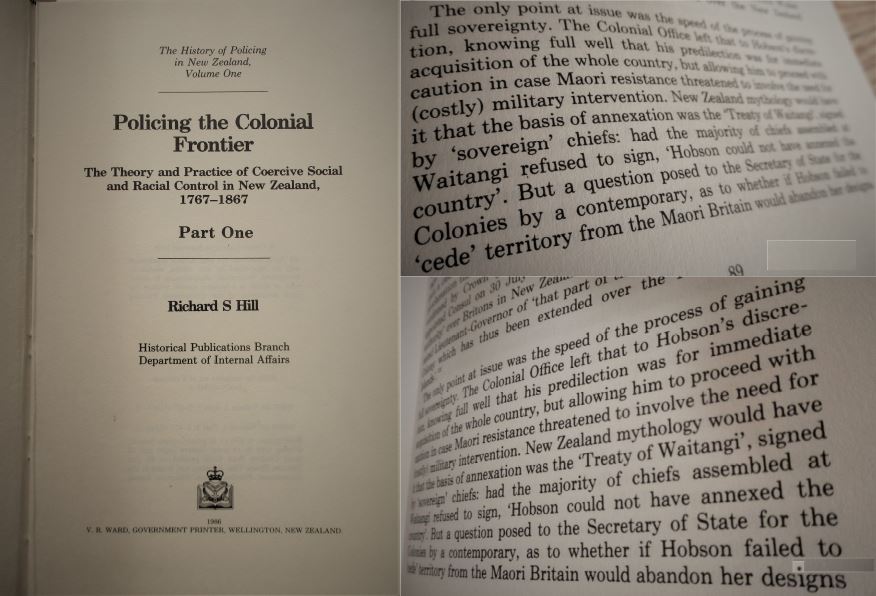
Hill stated in his 1986 history of policing in New Zealand, cession by treaty was a pretense to neutralize anticipated Māori opposition, stonewall representative civil government for settlers, and to deconstruct the façade of an ‘independent state’ of indigenous sovereignty designed by the British. xvi New Zealand’s first posted official, British Resident James Busby, constructed the edifice of an independent state with his initiative of the 1835 ‘Declaration of Independence’ or He Wakaputanga o te Rangatiratanga o Nu Tireni, which was first signed by 34 chiefs on 28 October 1835. The chiefs had their reasons for signing and had a long custom of periodically coming together to make decisions such as the challenges thrown up by the introduction of muskets. However, Busby stoked fears that Māori would be enslaved on the basis of a letter sent to him by a delusional Frenchman, Charles de Thierry, who claimed to declare sovereignty. Busby’s modus operandi was to turn any threat, real or perceived, into an opportunity and was part of the British strategy to game Māori.
The deconstruction of the façade of ‘indigenous sovereignty’ occurred, in part, because Busby never believed in rangatira sovereignty.
Not one bit.
On the 20 March 1834 – Busby lured his chosen rangatira aboard the HMS Alligator, to select a national flag for shipping. The chiefs had to prostrate themselves to get under a roped-off section inside a makeshift ‘tent’ made of sails on the deck. Curiously, the chiefs’ ‘choices’ – by no means unanimous – by a thin slither just happened to ‘pick’ the St George’s Cross, a motif that appears everywhere in English heraldry and is the symbol of England’s national flag.

The choice gets more curious when it is learned that the Templar Knights adopted the Red Cross in 1145, and French troops used it during the Third Crusade or the Kings’ Crusade, that was co-sponsored by Phillip II of France and Henry II of England, while English troops used a White Cross in 1188. George of Capadocia (modern day Turkey) or St. George, the Patron Saint of England, is venerated as a legendary champion of Truth and defender of the Christian religion.

The popular legend of St George valourizes his role as a soldier who saves a princess from the maw of a hungry dragon that won the customary right to eat sheep and children. With synchronicity, St George the Christian Knight just happened to be passing through the terrible scene. St George astutely saw an opportunity to expand the Church’s franchise and offered to save the princess on condition that the traumatized people convert to Christianity.
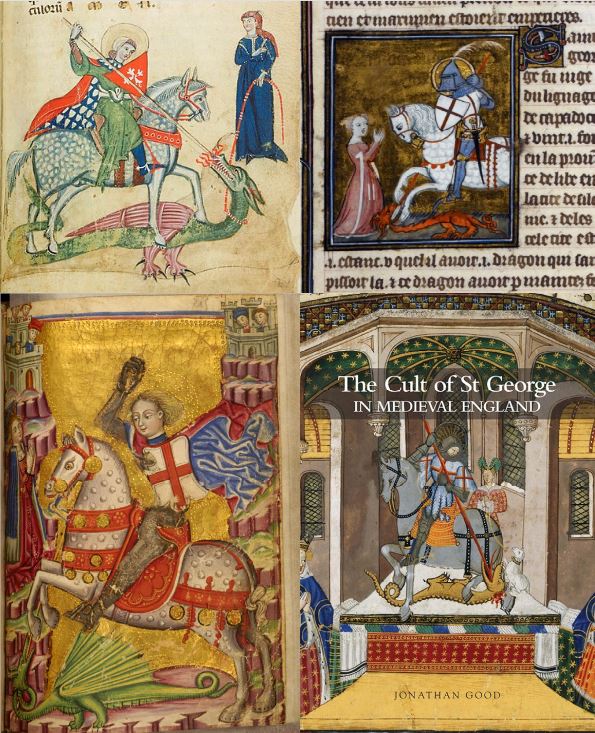
Therefore, Busby had successfully exploited the matter to get a national flag for Māori shipping from early 1833, as a cause célèbre mechanism to weld rangatira into a formalized collective federation of national purpose. This occurred after his serendipitous encounter in Sydney where he just happened to learn as he was leaving for New Zealand about the vexed matter of New Zealand-made ships that were impounded by Customs for entering in Sydney’s port without displaying a national flag. Thus, after this serendipitous encounter before leaving port, official British Resident James Busby’s saved Māori shipping commerce from the maw of the British Dragon of Maritime Traffic Infringements on the promise that they would convert to British Maritime Law, with the adoption of a national flag, complete with the St George’s Cross motifs and a shipping register.

The Royal Navy ‘recognized’ this flag with a 21-gun salute by the HMS Alligator, a British military tradition reserved for events involving heads of state. King William IV also ‘recognized’ the national flag and offered the British Admiralty’s protection of Māori shipping. It was also ‘recognized’ by the British Government and Royal Navy. In essence, the ‘recognition’ of the national flag for shipping was because Māori had inadvertently volunteered their international shipping to be under the jurisdiction of British Maritime Law. This expansion of the British Maritime franchise was an exquisite example of imperial incrementalism, embedded with the Discovery Doctrine elements of Christianity as symbolized by the St George’s Cross motifs, and Tribal Limited Sovereign and Commercial Rights, which assumed that indigenous peoples lost some of sovereign rights and powers on First Discovery.
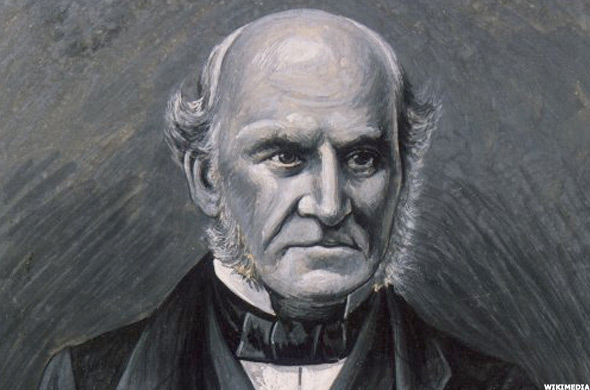
Busby’s curious habit of choosing solutions to advance Britain’s foothold in New Zealand also extended to the provocative circumstances that led to the sacking of his residency storehouse by Chief Rete on 30 April 1834, or just five weeks after Busby had stealthily activated the Discovery Doctrine’s elements of Tribal Limited Sovereign and Commercial Rights and Christianity with the chief’s selection of the United Tribes of New Zealand Flag that riffed-off the Crusades. Rete had inflicted a muru, or ritual compensation because Busby had interfered with Rete’s logging trade, which was his hapū’s economic activity, and also because Busby had wrested control of large areas of land. The British Resident – who was pushing his weight around after having enhanced his status – now played the victim, milking the fact that he had been shot at and lobbied for Rete’s execution. Naturally, he neglected to point out his culpability in land swindling and restraint of trade. Rete’s sacking of the British Resident’s residency was an exercise in rangatiratanga, as a 2012 report commissioned by the Kuia and Kaumātua of Ngāpuhi, entitled Ngāpuhi Speaks pointed out, but – conspicuously – the Waitangi Tribunal’s 2014 report on the 1835 Declaration and 1840 te Tiriti omitted.

Following the discovery that the sacking was the work of Chief Rete, Busby twice convened hui with rangatira to persuade them to support a punishment, while the HMS Alligator and the HMS Hyacinth, respectively, were at bay. Evidently, a ship of war had the desired effect, and at the first meeting, the rangatira were of the view that the culprit would be punished. Reverend Henry Williams advocated for forfeiture of Rete’s land and the chief’s banishment from the district. At the second hui – which occurred after Busby gained approval from New South Wales Governor, Sir Richard Bourke – rangatira objected to the idea of a large party of chiefs enforcing the punishment, since it would have been deemed too provocative. Busby – whose covert role was that of an Agent Provocateur effecting Discovery Doctrine elements – bribed rangatira with blankets and the native enforcement party swelled from 4 to 12.
To this end, Busby confiscated Rete’s land, that Busby estimated to be 130 acres, at the village of Puketona about four miles inland from Busby’s seaside residence at Waitangi, which was meant to be under the protection of Chief Te Kemara of Ngāti Rāhiri hapū. Busby requested that Rete’s relations burn down his huts, thereby inflicting a Humiliation Ritual of Rete’s hapū. Busby added the insult of naming the confiscated block, Ingarani, the Māori transliteration for England, and pompously claimed he had taken possession as the King of England’s farm. In this way, Busby was extending the Discovery element of Actual occupancy and current possession, to symbolically complete title to Cook’s annexation in the King’s name. When Busby learned that Rete had been staying in huts that Māori had customarily used while fishing in the area – on land that Busby claimed he had ‘purchased’ within a quarter mile of his residency – the British Resident personally burned down the fishing huts!

Busby’s arrogance was that he was not ignorant of his provocative transgressions. Busby actions were what you would expect of a psychopathic Agent Provocateur skilled in winning the confidence and submission of others – whom would ultimately become his victims – while projecting blame on his victim, Rete, for the consequences of the British Resident’s own British Imperial incursions. In effect, the British Resident was activating the Discovery Doctrine element of Tribal limited sovereign and commercial rights, since ‘First Discovery’ by a European held that indigenous peoples lost some of sovereign rights and powers. Therefore, James Busby acted as if his land swindling, restraint of Rete’s logging commerce and exacting retribution on a chief – were his right as a British official in accordance with the Tribal limited sovereign and commercial right element of Discovery.
In this way, the Protestant missionaries and the British Resident steered a confederacy of chiefs to declare their sovereignty on 28 October 1835, while at the same time seeking an alliance with King William IV to avert possible French Catholic missionary influence aligned with the Vatican Empire.
Rete inflicted a muru, or ritual compensation by night on April 30th 1834, because Busby had interfered with Rete’s logging trade, which was his hapū’s economic activity, and also because Busby had wrested control of large areas of land. The British Resident – who was pushing his weight around after having enhanced his status just five weeks after the United Tribes of New Zealand Flag was chosen – now played the victim, milking the fact that he had been shot at. Naturally, he neglected to point out his culpability in land swindling and restraint of trade.
Ironically, from the perspective of British state officials, ‘the Natives’ whom inhabited New Zealand were high in the scale of ‘uncivilized races’. Because Māori were still cast as ‘savages’ – they were deemed to possess no Constitution of a political character that could act as a legislature, exercise national independence or perform international functions that European Powers would recognize.xvii By this reckoning, ‘uncivilized natives’ could not be expected to fully comprehend the agreements and therefore any political equity and native agency that indigenous peoples did possess was diminished. The predicament of indigenous peoples furthered exacerbated by an unwillingness to tell the truth, with the assistance of maps, pictures and diagrams depicting the rivalries within and between the empires.
A recap of Busby’s machinations demonstrates the British game play to construct a ‘Treaty Theatre Track’.
By exquisite serendipity, New Zealand’s first British official learned of the woes of Māori shipping while departing for New Zealand at Sydney Port. British Resident James Busby cast himself as the heroic protagonist in the Cult of St George. As a reworked Dragon Slayer character, Busby saved Māori shipping commerce from the maw of the British Dragon of Maritime Traffic Infringements. In keeping with the legend of St George, he only does so by extracting a ‘pound of flesh’ from ‘the Natives’ by gaining their conversion to the cult of British Maritime Law, with their ascent to the adoption of a national flag, complete with the St George’s Cross for replication as motifs and a shipping register. Embedded in Busby’s machinations is the gaining of submission of selected chiefs, whom he lures to prostrate themselves to go under a British shipping rope inside a white tent made of sails on the deck of a Royal Navy ship named after a tropical reptile, HMS Alligator. Without knowing it, the rangatira have been tricked into participating in a precedent-setting Westminster Parliamentary-style of voting, to select a flag design. By a narrow margin, and with exquisite serendipity, Busby’s selected chiefs just happen to choose the one with the St George’s cross on it. With this chiefly ascent, Busby successfully riffs off Crusades history, by embedding the red version of St George’s Cross used by the French in the Kings’ Crusade or the Third Crusade, to stick it to the French. Doubtless, these machinations entertained Busby greatly.
Next, he antagonized a local chief, Rete, by bossing him and his hapū around about how to conduct their logging commerce. Busby lobbied for Rete’s execution after the evidently insubordinate chief ransacked Busby’s storehouse, and the British Resident copped a wood-splinter wound to his face when a musket shot hit the back-door frame, from where Busby had disturbed ‘the Natives’ one night in the midst of exacting a muru, or ritual compensation, in keeping with Māori customary law. New South Wales Governor Sir Richard Bourke permitted inflicting a retaliatory punishment. Rete’s huts were burnt and 130 acres of his village, Puketona, were confiscated and Busby renamed it Ingarani, the Māori transliteration for England. Having set the precedent of the first land confiscation in New Zealand by a British official, Busby then conned 52 chiefs over a four-year period to sign his so-called Declaration of Independence, following the first signings on October 28th 1835. Thus, with a full deck of cards worth of chiefly marks and signatures, the British were able to construe that New Zealand was an ‘independent state’ – while, curiously, at the same time the entire islands of New Zealand became a protectorate of the British Crown, meaning it was not in the least bit independent if it could not defend itself from a foreign power, whether French, English or American.
The incontrovertible fact is that Busby acted as an agent provocateur seeking to structurally entrap rangatira into breaching international and British maritime law, and he succeeded with Chief Rete. Busby’s provocation occurred after he had conned chiefs to vote for a flag of national shipping and therefore, volunteer their submission to British Maritime Law, and join in the system of international law. Having successfully inflicted the first land confiscation with the participation of about a dozen rangatira, Busby then deployed his defining confidence trick, gaining chiefly participation in signing the 1835 ‘Declaration of Independence’, or He Whakaputanga o te Rangatiratanga o Nu Tirene. In the drafting of this Declaration, there was no problem with terminology to establish chiefly sovereignty, in both the English and Māori language versions. Whereas, there were crucial differences between the drafts of the Māori language and English language versions of the 1840 Waitangi Treaty. That is not simply because Busby recruited the help of Eruera Pare Hongi, to draft the Māori language version of 1835 ‘Declaration of Independence’, while in the translating of the English version of the Treaty of Waitangi into the te reo Māori version, Te Tiriti o Waitangi, there was no indigenous hand or eye. The real reason is because the British game had been to erect the edifice of an independent sovereign state for its deconstruction at a later date.
Fascinatingly, Foden’s ground-breaking books of 1938 and 1965 were written at a time before the discourses on language translation differences became commonplace in treaty scholarship. The implication is that even Foden, who was barrister and solicitor of the New Zealand Supreme Court, missed just how crafty the ‘Treaty Cliqué’ were, since their ‘Waitangi Treaty Theatre Script’ spun on a fulcrum that involved the deceptively crafted, language translation differences.
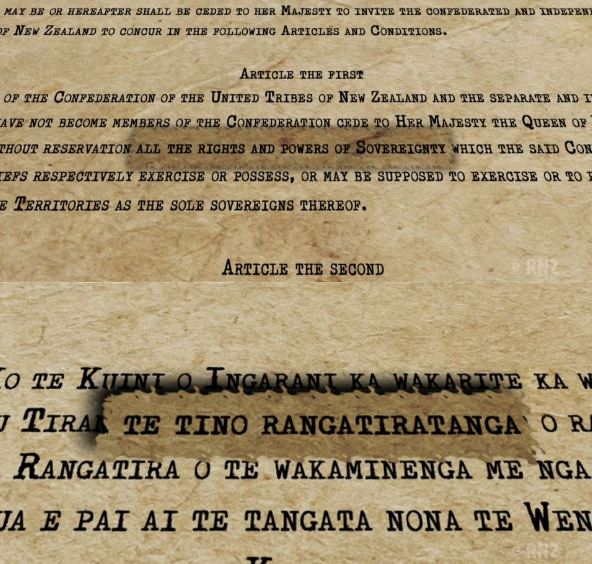
According to Article One of the English language version of the Treaty, the chiefs ceded forever their full sovereign powers, while in Article One of te Tiriti o Waitangi, the chiefs conferred the right to Queen Victoria to appoint a Governor to Rule over Pākehā and Article Two, the chiefs or rangatira retained their rangatiratanga, or full sovereign powers. This crucial switch was deliberate because Reverend Henry Williams who translated Busby’s English draft into te reo Māori had no trouble understanding the distinction in these words since he was alongside Eruera Pare Hongi, translating the 1835 Declaration of Independence into English, in which the signing chiefs clearly declared their chiefly mana and rangatiratanga, or sovereign authority.
In October 2014, this historical deception was made emphatically clear by the Waitangi Tribunal,xviiiwho found that Māori did not sign away sovereignty when 512 chiefs, or rangatira, signed Te Tiriti o Waitangi of 1840.
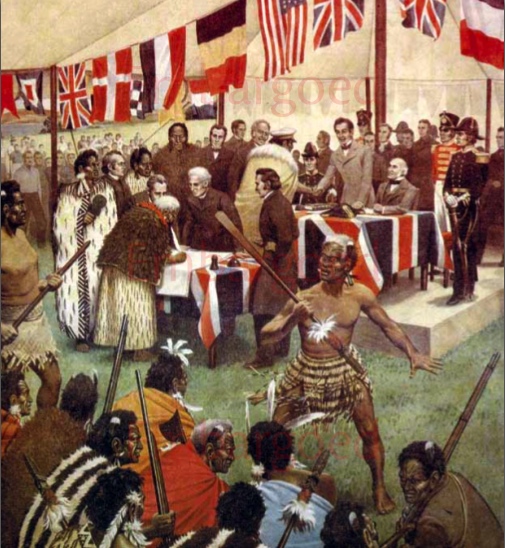
Forty-three chiefs signed Te Tiriti o Waitangi at Waitangi on 6 February 1840. Most of the treaty sheets that were signed by rangatira were in Māori. The 39 chiefs, who subsequently signed the English version, were all assured by the Crown’s agents that their chiefly authority would remain intact, as Dame Claudia Orange found in her imaginatively titled, Goodman Fielder Wattie award-winning 1987 book, The Treaty of Waitangi.xix
Furthermore, those Māori that signed were convinced by the sales-pitch of Captain Hobson and Associates that they were signing a treaty with a great power to not only discipline troublesome Pākehā, but also to address land-swindling and protect Māori from foreign invaders in exchange for trade, limited immigration and co-development.
The Waitangi Tribunal noted the crucial assurances of Lieutenant-Governor Hobson his agents and the Protestant missionaries given to rangatira: (1) Queen Victoria would not dispossess Māori of their lands they did not willingly sell; (2) Māori would not become enslaved; and (3) rangatira would still retain their chiefly authority.xx
The Waitangi Tribunal explored the meanings ‘lost in translation’ between the English and Māori language versions of the Treaty of Waitangi.xxi The Tribunal noted the controversial use of the word Kawanatanga or governorship, in Article One of the Māori language version, which was rendered to mean sovereignty in the English language version, by Church of England Reverend, Henry Williams.xxii The effect was that Kawanatanga was essentially construed to mean that Māori ceded sovereignty over New Zealand forever to the Queen of England!xxiii Crucially, Māori chiefs thought they retained their chieftainship, or independent authority, with the crucial term – tino rangatiratanga – in Article Two of the Māori language version. Both mana and tino rangatiratangawere regarded as paramount, spiritually sanctioned, inalienable power, as Emily Blincoe noted in her law paper, “The Myth of Cession: Public Law Textbooks and The Treaty of Waitangi”, that endorsed the Tribunal’s report.xxiv
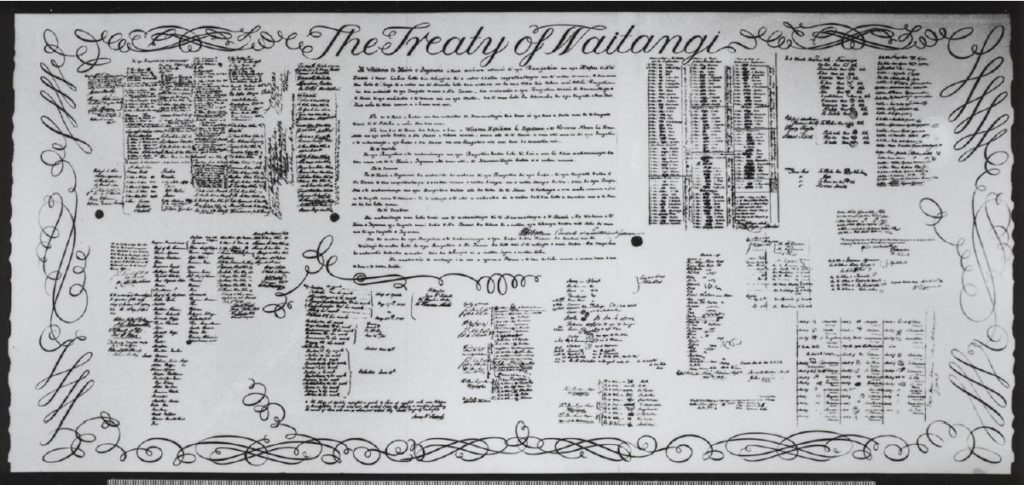
However, the multi-year scholarly investigation of the Waitangi Tribuanl – which is a body of the Ministry of Justice – as well as the excellent field research undertaken Te Kawariki & Network Waitangi Whangarei that was Commissioned by Kuia and Kaumātua of Ngāpuhi to produce their 2012 report Ngāpuhi Speaks: He Whakaputanga o te Rangatiratanga o Nu Tireni and Te Tiriti o Waitangi, missed the real significance of the parallel legal moves that included proclamations, new commissions, swearing-in officials, letters patent, legislation, gazetted notices and a royal charter that ‘legalized’ the British Crown’s annexation of New Zealand as a colony of her Majesty’s Empire.

Therefore, the hidden purpose of the 1840 Treaty of Waitangi was to construct the legal justification to take-over New Zealand – without actually spelling that out – as The Snoopman’s Waitangi Day 2018 report titled, “Harnessing the Herd to Hide a Historical Heist: The Crown’s breach of the Crimes Act”, gazetted in the conservative liberal website, The Daily Blog, AUT University’s Asia Pacific Report and MultiMedia Investment Limited’s Lives News.
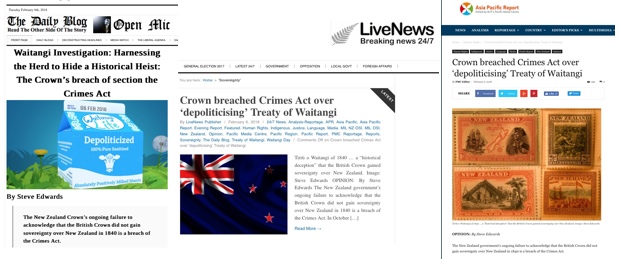
When the ‘rebellious natives’ predictably and eventually ‘reneged’ on their side of the bargain – by fighting back – the British Navy and Army would action the Conquest element of the Doctrine of Discovery.xxv This eventuality, about how the conversion of paper sovereignty into sovereignty of substance would occur, was omitted from all versions of the Treaty – Māori and English. In other words, the Treaty signing rituals were the set-up of this ‘long-game’ that cast unwitting Māori into a wedge of war, where struggles over soil would be fought.xxvi To be more precise, the Treaty of Waitangi was a manifestation of the Doctrine of Discovery element of Preemption/European Title.xxvii Thus, conquest not only refers to military victories, often legitimized as a ‘just war’. Conquest also refers to the act of First Discovery since indigenous Māori were considered ‘savages’ who did not have full political rights.
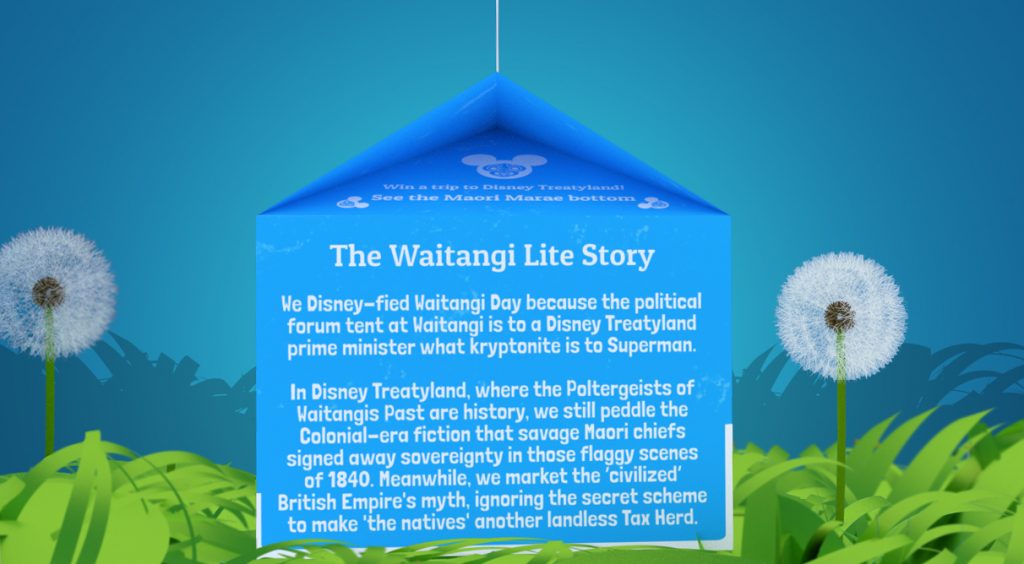
Therefore, Prince Charles’s ceremonial activities at Whenuapai and Waitangi were rituals of possession and occupation. These included: (1) the flag planting ritual at Whenuapai Airbase took the form of presenting new Queen’s Colours to the Royal New Zealand Air Force; (2) a homage to the ‘Waitangi Treaty Theatre Director’ Captain Hobson at the stone memorial; (3) a tree planting on the Waitangi Treaty Grounds; (4) presenting a korowai as a loan to the Waitangi Museum; (5) and the performance of a vocal ritual with his speech at Waitangi, which cemented the myth of cession. The Prince’s visit was quite deliberately timed to follow the closure of the Tuia250 Encounters tour commemorating Cook’s Endeavour voyage of ‘discovery’ and possession rituals.

—-
To sum-up, the New Zealand Government failed to admit during Prince Charles’s visit that the takeover of New Zealand occurred through the application of the Discovery Doctrine’s Settlement element, with a series of legal moves signed off by Prince Charles’s great, great, great grandmother, Queen Victoria. Those legal moves – which began with the Letters Patent of Boundary Extension on June 15th 1839 and effectively completed with the Royal Charter for Severance 16th November 1840 to establish New Zealand as separate colony – were mechanisms consistent with English constitutional law, and were – in effect – the track laying vehicle for the creation of New Zealand as British. Meanwhile, the 1840 Waitangi Treaty was theatre to create the appearance that New Zealand became a colony through treaty cession.

A splintered group that ‘represented’ the Ngāpuhi leadership at Waitangi displayed a remarkable lack of ballsiness, principled resolve and far-sighted vision, because they have, in effect, endorsed the British-penned Treaty myth – which they know to be untrue. They have, therefore, submitted to the Prince’s ‘Royal Charm Offensive’ rituals amid the tail-end of the Tuia250 Encounters tour and poignantly just after the 250-year mark of Captain Cook claiming to have performed a possession ritual at Mercury Bay in mid- November 1769.
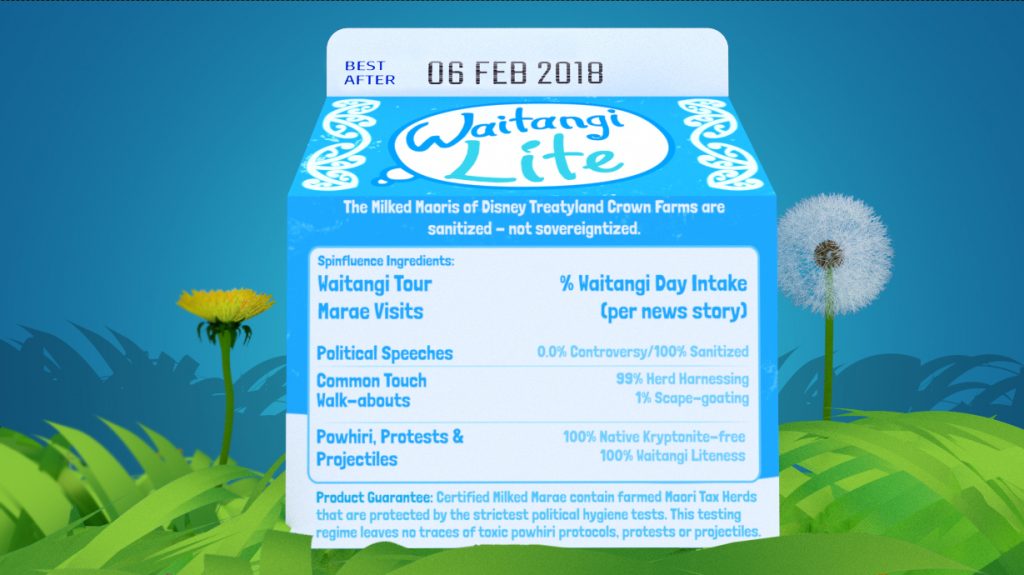
In effect, Northland’s largest iwi, Ngāpuhi has endorsed a Waitangi Disney Treatyland mythology through their failure to present ‘HRH’ – The Prince of Wales, with a copy of the Waitangi Tribunal’s scholarly 600-page October 2014 report, and their own commissioned, excellent field report, Ngāpuhi Speaks. Those two reports both found that the Ngāpuhi Treaty Chiefs believed they were conferring Queen Victoria the right to appoint a governor to rule over Pākekā, and did not wittingly sign away their sovereignty in 1840.

Similarly, the New Zealand Crown also avoided fessing up to the tax-herds of the Realm of New Zealand that the British Crown activated the Discovery Doctrine through Royal Navy Captain Bro. James Cook during the ‘Tuia Enounters 250’ commemorations that marked the 250th Anniversary of the Endeavour Voyage when Cook circumnavigated New Zealand in 1769-70. Indeed, Captain Cook’s alleged performance of possession rituals at Mercury Bay around November 15th 1769 and Queen’s Charlotte Sound on January 31st 1770 when he asserted to have claimed possession of lands for King George III, set in motion the eventual British takeover of New Zealand.
Prince Charles’s rhetoric was characteristically vague, riddled with inaccuracy and key omissions of fact and was, therefore, an exquisite exemplar of British Royal propaganda intended to manufacture the submission of Māori, Pākehā and other tax-herds of the Realm of New Zealand.
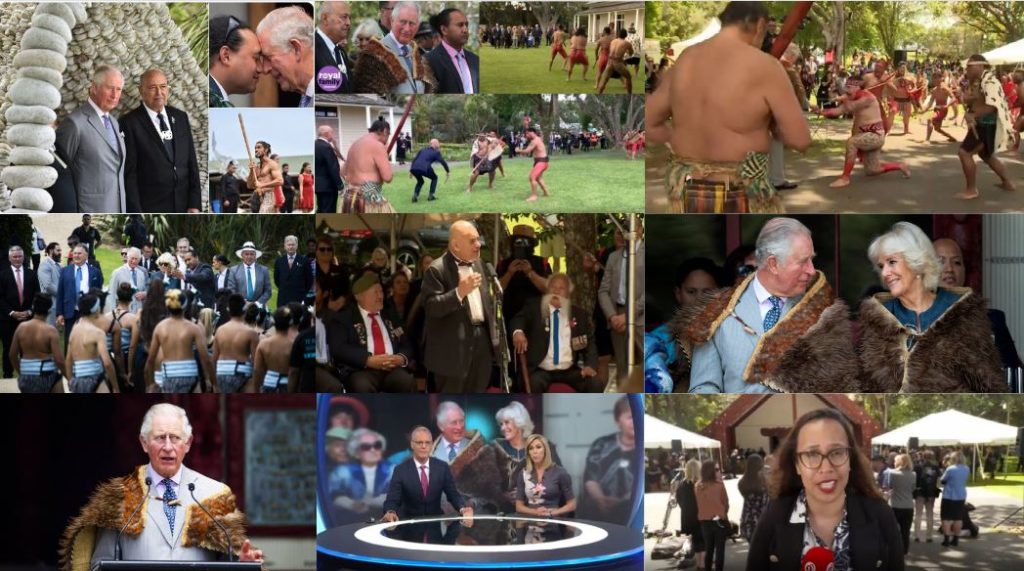
The Prince of Wales’s performances of Actual Occupation and Current Possession, Preemption/European Title and Sovereign Conquest rituals, demonstrates that the Discovery Doctrine is ‘alive’. The billionaire neo-feudal Royal landlord also performed a speech that was, in effect, vocal symbol. Because his carefully chosen words occurred at a historically significant, tightly controlled, politically symbolic place, the prince’s propagandist delivery was also a concrete symbol of British sovereign power designed to cement the enduring submission of Ngāpuhi and Māori in general – lest the myth of cession become widely exposed.
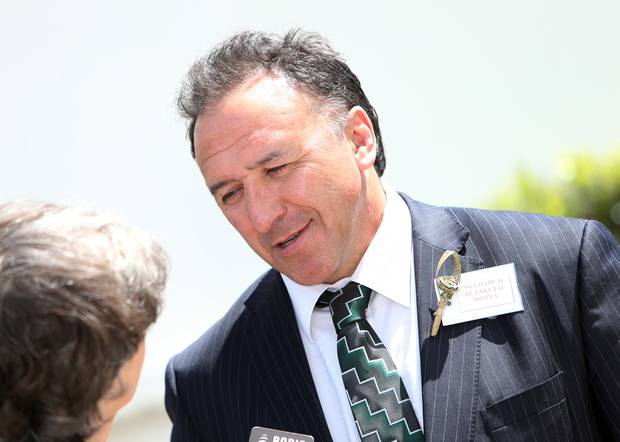
If that were to occur, the British Monarchy’s fraudulently gained ancestral claim to paper sovereignty and violently won claim to substantive sovereignty of the soil and sea would collapse. Such a result would likely lead to a snow-balling effect, manifesting as the exquisitely entertaining catastrophic collapse of the vampiric British Royal Family Firm — forever — ake, ake, ake!
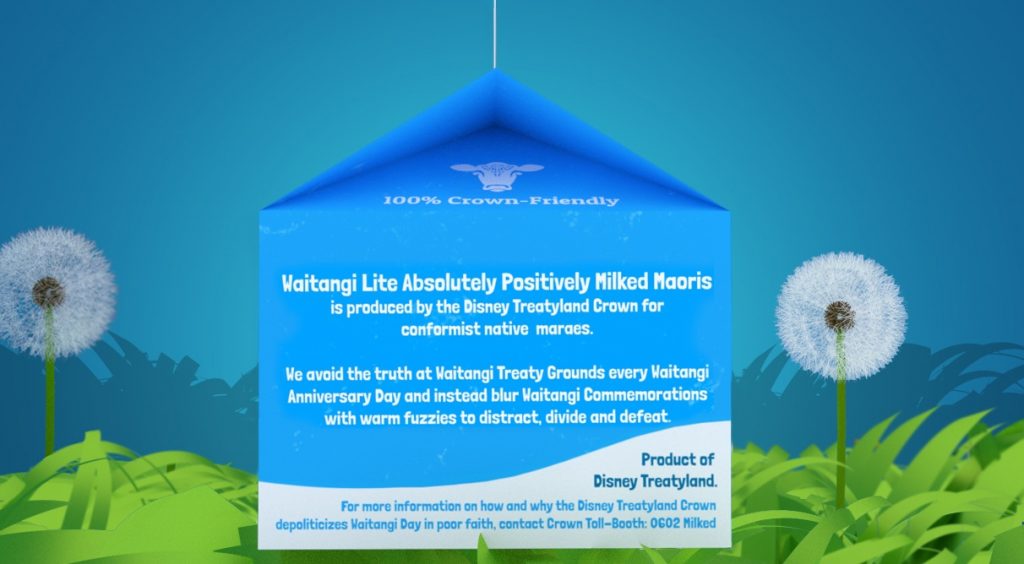
====
In “Royal Landlord Possession Rituals”, The Snoopman shows further shows the Prince of Wales’s speech at Waitangi reinforced the enduring myth of cession, which holds that the Treaty Chiefs consciously and freely signed away sovereignty in 1840. When, in fact, British Crown gained paper sovereignty over New Zealand by laying a separate legal track laid in 1839 and 1840 parallel to the Treaty-making rituals – with the royal seal of approval of Prince Charles’s the great-great-great grandmother, the Germanic-born Queen Victoria of the House of Saxe-Coburg and Gotha.
That separate track – which is outlined in more detail with documentary imagery – perfected the incomplete title stealthily gained by Captain James Cook. In effect, the 1840 Waitangi Treaty was New Zealand’s second theatrical production – the first being Captain Cook’s Endeavour voyage. The alignments of the Ngāpuhi leadership to the power clique on the board of the Waitangi Museum is revealed, to explain why a faction of the Ngāpuhi leadership displayed a remarkable lack of ballsiness, principled resolve and far-sighted vision – because by their submission to Royalty they have, in effect, endorsed the British-penned Treaty myth – which they know to be untrue.
This investigation shows the Prince of Wales’s charm offensive contained carefully codified communications were designed primarily for an élite audience attuned to the language of metaphor, Discovery Doctrine rituals and crisis rituals to retake control of national narratives. The Snoopman demonstrates that Northland’s largest iwi, Ngāpuhi has – in effect – endorsed a Waitangi Disney Treatyland mythology through their failure to present The Prince of Wales with a copy of the Waitangi Tribunal’s 600-page October 2014 report, which found that the Ngāpuhi Treaty Chiefs believed they were conferring Queen Victoria the right to appoint a governor to rule over Pākehā, and did not wittingly sign away their sovereignty.
Crucially, Prince Charles said was reaffirming his ‘commitment’ to the ‘bond’ made in 1840 by the signing of the Waitangi ‘convenant’ between two peoples for his children and grandchildren and and to ensure it endured for future generations. claimed that each successive generation of his family has held dear the bond made in 1840 by the signing of the Waitangi ‘convenant’. This remark passed unchallenged in spite of much dark evidence to the contrary, such as the instrumental roles played by two of his war-mongering great, great uncles, that embroiled New Zealand in Britain’s wars of conquest, specifically the Waikato War of 1863-64 and World War I as part of a diabolical plot resolved upon by Secret British Élite in February 1891 to forge a world empire through two planned world wars. This dark history of the British Monarchy is pertinent, because the Waitangi National Trust is due to open the Māori Battalion Museum on February 5th 2020. The museum’s idea is to amplify the words spoken by Sir Apirana Ngata that serving in World War II was “the price of citizenship.” It will commemorate the Māori sacrifices of 28th Māori Battalion in World War II, as well as the Pioneer Battalion of World War I and include a small section devoted to Britain’s wars of conquest against Māori in 1845-46 and 1860-1872.
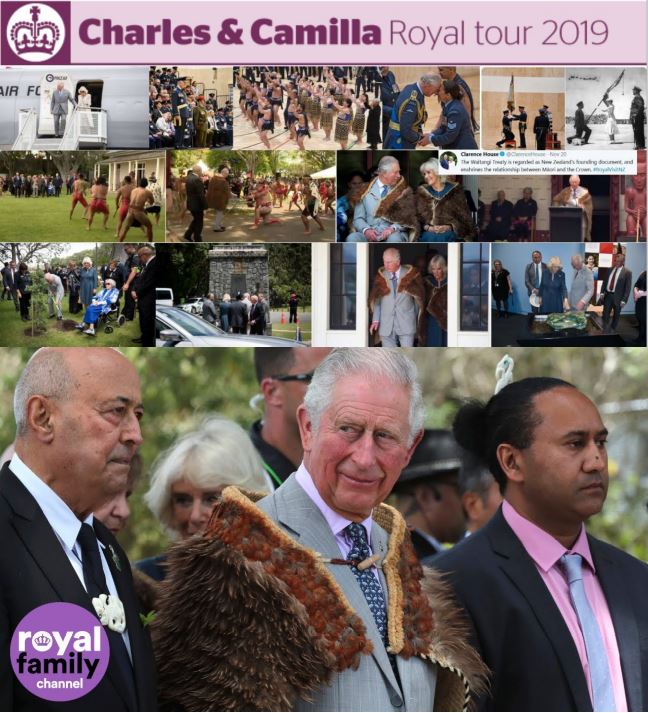
Sourced References:
i RNZ. (20 November 2019). Prince Charles, Camilla visit Waitangi Treaty grounds, local schools. https://www.rnz.co.nz/news/national/403757/prince-charles-camilla-visit-waitangi-treaty-grounds-local-schools
ii Daniel Aston. (5 August 2017). The land and property Prince Charles owns in Cornwall revealed. https://www.cornwalllive.com/news/cornwall-news/land-property-prince-charles-owns-287981
iii Charles praises brave, compassionate NZ Ben McKay, Australian Associated Press November 20, 2019 https://www.townsvillebulletin.com.au/news/breaking-news/eyes-on-historic-royal-visit-to-waitangi/news-story/a9426cad236c2111937a228c755ef78b?fbclid=IwAR0qJx5LC9x3-qfFZZgzC1a8Ft1DD8DQI2EaxbnCGDgPz35RuGMc_X_7P9g
iv Monarch’s Colour http://navymuseum.co.nz/monarchs-colour/
v Changing of the Royal New Zealand Navy Queen’s ColourLt Gen The Rt Hon Sir Jerry Mateparae, GNZM, QSO 1 October 2011 https://gg.govt.nz/publications/changing-royal-new-zealand-navy-queens-colour
viN. A. Foden.(1965). New Zealand Legal History (1642-1842), p. 3.Wellington; New Zealand: Sweet & Maxwell.
viiRichard Knight. (30 June 2000). Speaking rights row goes to elders’ hui. https://www.nzherald.co.nz/nz/news/article.cfm?c_id=1&objectid=12286440&&ref=topbox
viii Steve ‘Snoopman’ Edwards. (September 18, 2018). Harnessing the Herd to Hide a Historical Heist: How and why the Crown’s marketing of the myth that Māori signed away sovereignty in 1840 breaches the Crimes Act of 1961. (Originally published on The Daily Blog, 6 February, 2018). Retrieved from https://snoopman.net.nz/2018/09/18/harnessing-the-herd-to-hide-a-historical-heist/
ixJo Moir. (19 November 2019). Ihumātao: Crown considers loan for Auckland Council to buy land. https://www.rnz.co.nz/news/political/403588/ihumatao-crown-considers-loan-for-auckland-council-to-buy-land; Leigh-Marama McLachlan. (20 November 2019). Ihumātao: Mana whenua disappointed over talk of $40m loan to council https://www.rnz.co.nz/news/te-manu-korihi/403721/ihumatao-mana-whenua-disappointed-over-talk-of-40m-loan-to-council?fbclid=IwAR2b2J_kQOX-Xa_YTV6oKHUwf6hcQRoc4u7kmanRmmBGiFtWZVbhF2FoF5g
x Miller, Robert J. & Ruru, Jacinta. (2009). An Indigenous Lens into Comparative Law: The Doctrine of Discovery in the United States and New Zealand, Vol. 111, 849-918. West Virginia Law Review.
xi Robert J. Miller. (2012). THE INTERNATIONAL LAW OF COLONIALISM: A COMPARATIVE ANALYSIS, p. 855-856. The Future of International Law in Indigenous Affairs: The Doctrine of Discovery, the United Nations, and the Organization of American States SYMPOSIUM. Lewis & Clark Law Review.
xii N. A. Foden. (1938). Constitutional Development of New Zealand in the First Decade (1839-1849). Wellington, New Zealand: L. T. Watkins Ltd; Richard S. Hill. (1986). Policing the Colonial Frontier: The Theory and Practice of Coercive Social and Racial Control in New Zealand 1767-1867 – Part One, p. 88-90. Wellington, New Zealand: Historical Publications Branch Department of Internal Affairs.
xiii N.A. Foden. (1938). Constitutional Development of New Zealand in the First Decade (1839-1849), p. 24.
xiv N. A. Foden.(1965). New Zealand Legal History (1642-1842), p. 80, 82.
xv Foden. (1938). Constitutional Development of New Zealand, p. 182-183.
xvi Richard Hall (1986). Policing the Colonial Frontier.
xvii Foden said, “the Maori nation had never attained
[the]
status” capable to “contract as a defined political unit.”
xviiiWaitangi Tribunal. (October 2014). He Whakaputanga me te Tiriti: the Declaration and the Treaty. The Report on Stage 1 of the Te Pararahi o Te Raki Inquiry. Wai 1040. Retrieved from: www.waitangitribunal.govt.nz
xixClaudia Orange. (1987). The Treaty of Waitangi. Wellington, New Zealand Allen & Unwin Port Nicholson Press.
xxWorried Māori chiefs voiced their concerns. Ngāi Tawake rangatira Rewa spoke prophetic insights when he said, “What do Native men want of a Governor? … Send the man away; do not sign the paper; if you do you will be reduced to the condition of slaves, and be obliged to break stones for the roads. Your land will be taken from you, and your dignity as chiefs will be destroyed.” Excerpt of kōrero. Waitangi Treaty hui of February 5 & 6, 1840. As cited In: Waitangi Tribunal. (October 2014). He Whakaputanga me te Tiriti: the Declaration and the Treaty, p. 358.
xxiTe Tiriti O Waitangi – The Treaty of Waitangi. Footnotes of Maori Text by Prof. Hugh Kawharu. Retrieved from: https://nzhistory.govt.nz/files/documents/treaty-kawharau-footnotes.pdf
xxiiThe English language version was wrongly registered in London on 15 October 1840 as a translation of the Māori language version. Claudia Orange. (1987). The Treaty of Waitangi, p. 85
xxiii Rev Henry Williams was well aware of the imperfections in the translation. “If Williams had used the terms ‘ko te kingitanga ko te mana’ (as he did in He Wakapūtanga) to translate ‘sovereignty’ in Ture 1 of te Tiriti, and asked the rangatira to cede these powers to the British Crown, it is almost certain that they would have been angry and affronted, and that the negotiations would have failed. Instead, he couched the cession to Queen Victoria as a tuku or release of ‘kāwanatanga”, stated Anne Salmond. Waitangi Tribunal. (October 2014). He Whakaputanga me te Tiriti: the Declaration and the Treaty, p. 464. Moreover, the comparative shortness of the First and Second Articles in the Māori version shows the inadequacy since Māori translations of English uses more words.
xxivEmily Blincoe. (2015). “The Myth of Cession: Public Law Textbooks and The Treaty of Waitangi”, p. 8-9. Faculty of Law, Victoria University. Retrieved from: http://researcharchive.vuw.ac.nz/xmlui/bitstream/handle/10063/5021/paper.pdf?sequence
xxvThe Doctrine of Discovery was a secret piece of international law that emerged during the Crusades between 1096 and 1271 when the Vatican Empire sought to forge a universal empire and was further developed by European nations in the 15th Century when they were also forming empires. The Discovery Doctrine was designed to mitigate the chances of competing nations making expensive war with each other. It was thought it would be easier to gain territory off indigenous peoples’ cast as ‘savages’ rather than from their more technologically even European competitors. Scholar Professor Robert J. Miller, who published his findings in a book titled, Native America, Discovered and Conquered, identified ten elements of the Discovery Doctrine. The ten Doctrine of Discovery elements are: (1) First Discovery; (2) Actual Occupancy and Current Possession; (3) Preemption/European Title; (4) Indian Title; (5) Tribal Limited Sovereign and Commercial Rights; (6) Contiguity; (7) Terra nullius; (8) Christianity (9) Civilization; and (10) Conquest. SEE: Robert J. Miller (2006). Native America, Discovered and Conquered: Thomas Jefferson, Lewis & Clark Manifest destiny. p.10. Westport, Connecticut; USA: Praeger; Professor Robert J Miller. (March 30, 2012) The Doctrine of Discovery: The International Law of Colonialism, Lewis & Clark Law School. Indigenous Peoples Forum on the Impact of the Doctrine of Discovery. Retrieved from: http://doctrineofdiscoveryforum.blogspot.co.nz/2012/03/doctrine-of-discovery-international-law.html; “The Still Permeating Influence of the Doctrine of Discovery in Aotearoa/New Zealand: 1970s-2000s – Foreshore and Seabed”, p. 237-239. In: Robert J. Miller, Jacinta Ruru, Larissa Behrendt and Tracey Lindberg. Discovering Indigenous Lands: The Doctrine of Discovery in the English Colonies, p. 6-8. Oxford, UK: Oxford University Press.
xxviSteve ‘Snoopman’ Edwards. (25 April 2017). “The Masonic New Zealand Wars”. Retrieved from:
The Masonic New Zealand Wars: Freemasonry as a Secret Mechanism of Imperial Conquest During the ‘Native Troubles’
xxviiIvison, D., Patton, P. & Sanders, W. (2000). Political Theory and the Rights of Indigenous Peoples. Cambridge, United Kingdom: Cambridge University Press; Silver, M., Pugh, M. & Harry, D. (2003). The Leech and the Earth Worm. [Motion Picture]. Nevada, USA: IPCB Production. Retrieved from: http://www.ipcb.org/publications/video/files/film_project.html

